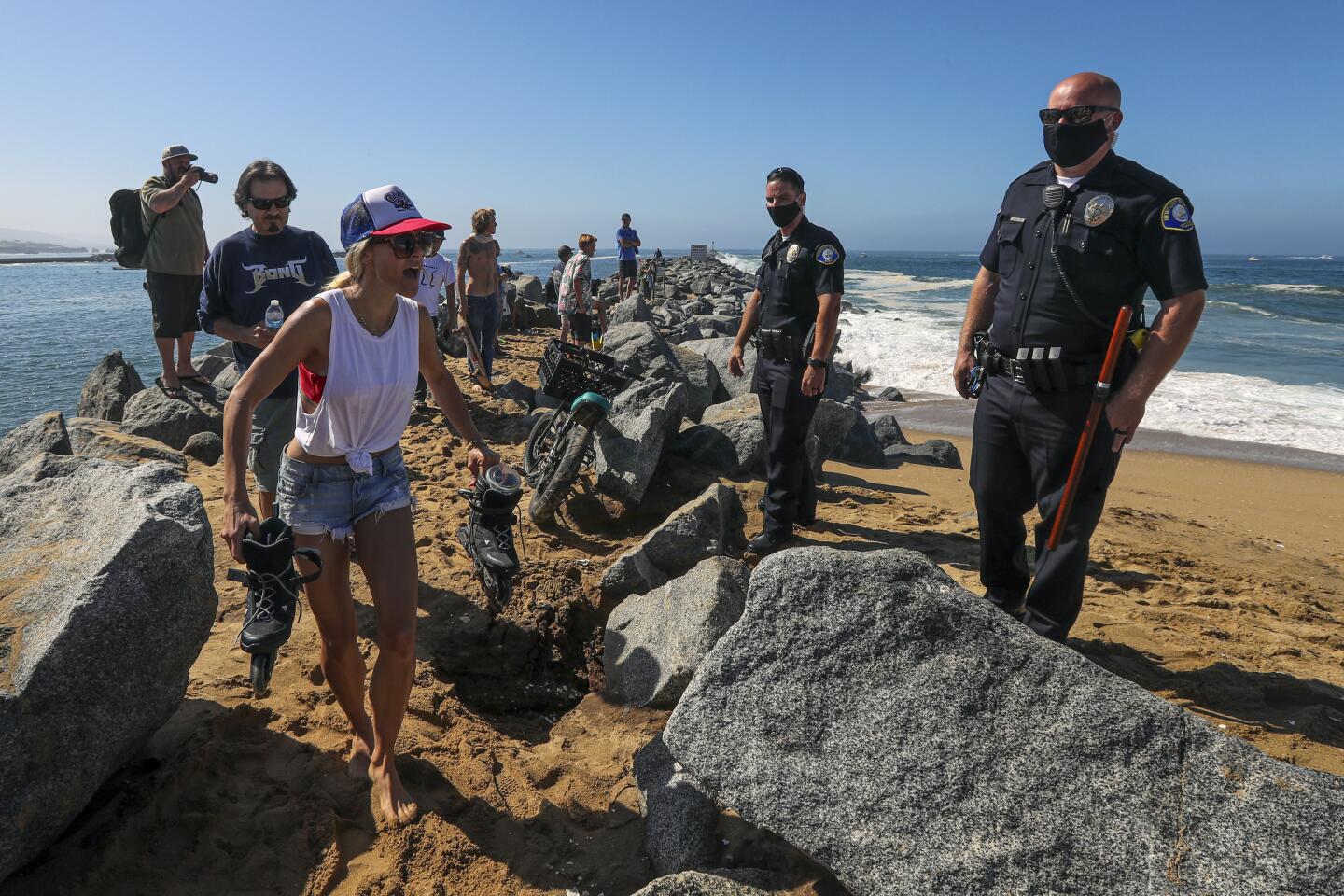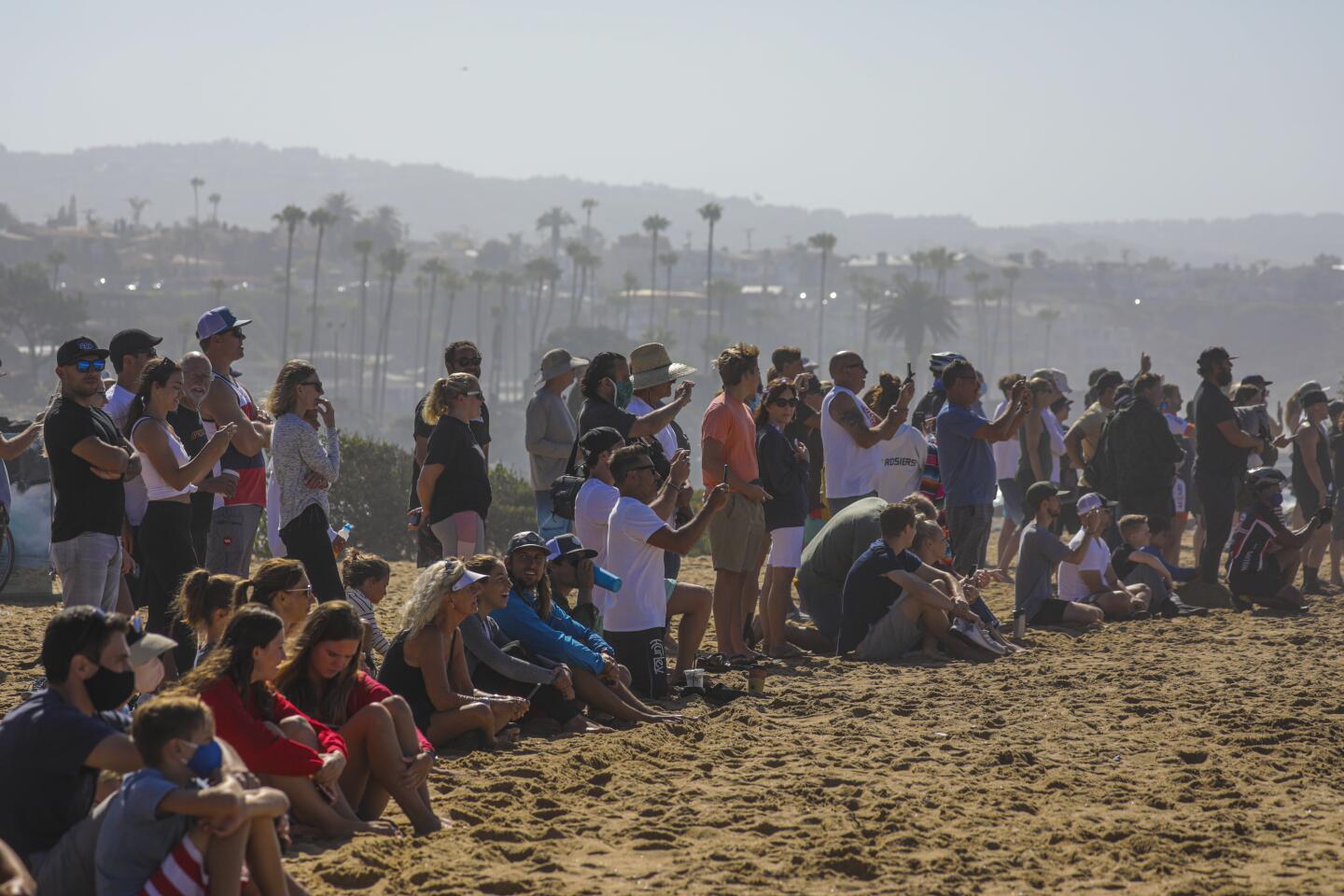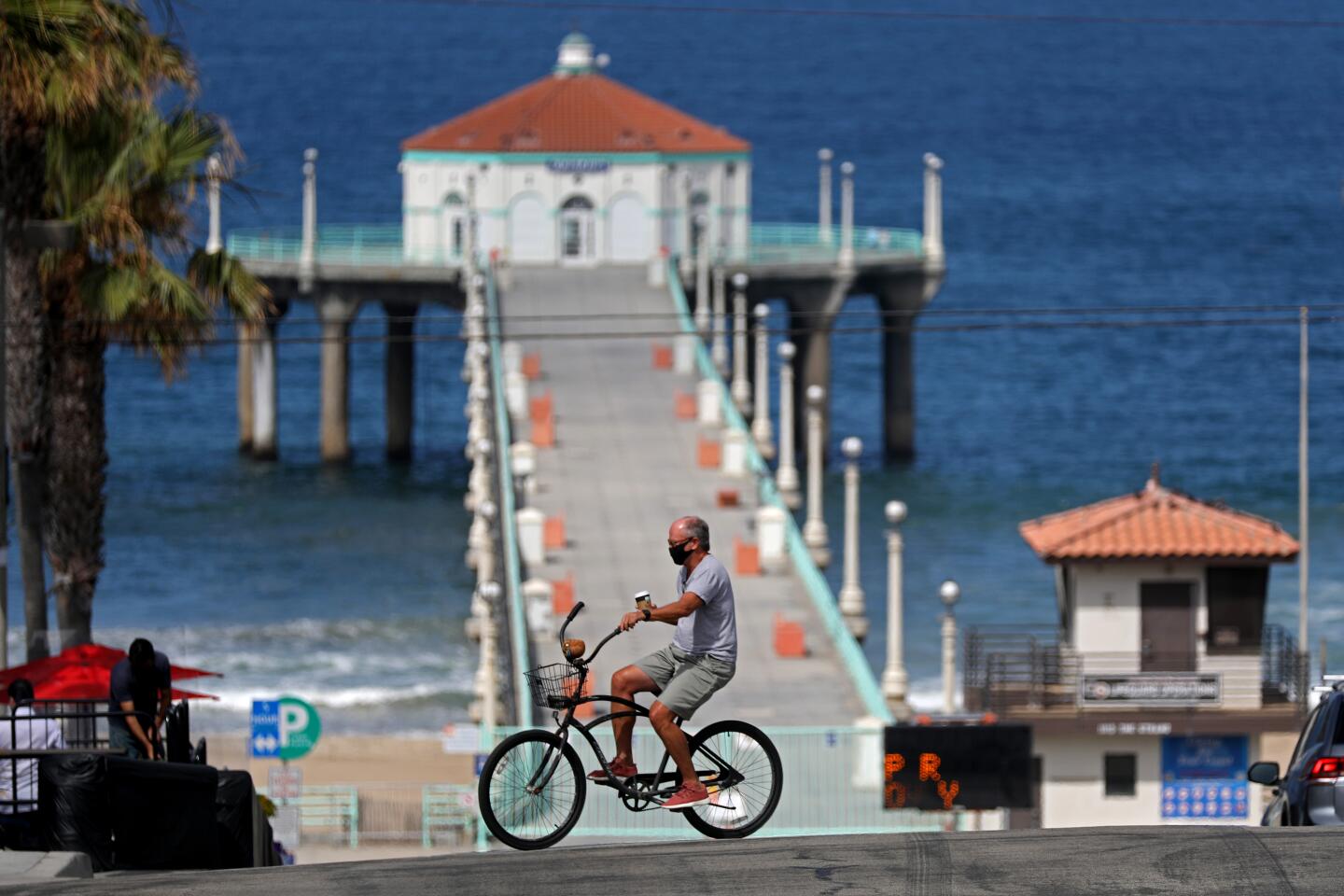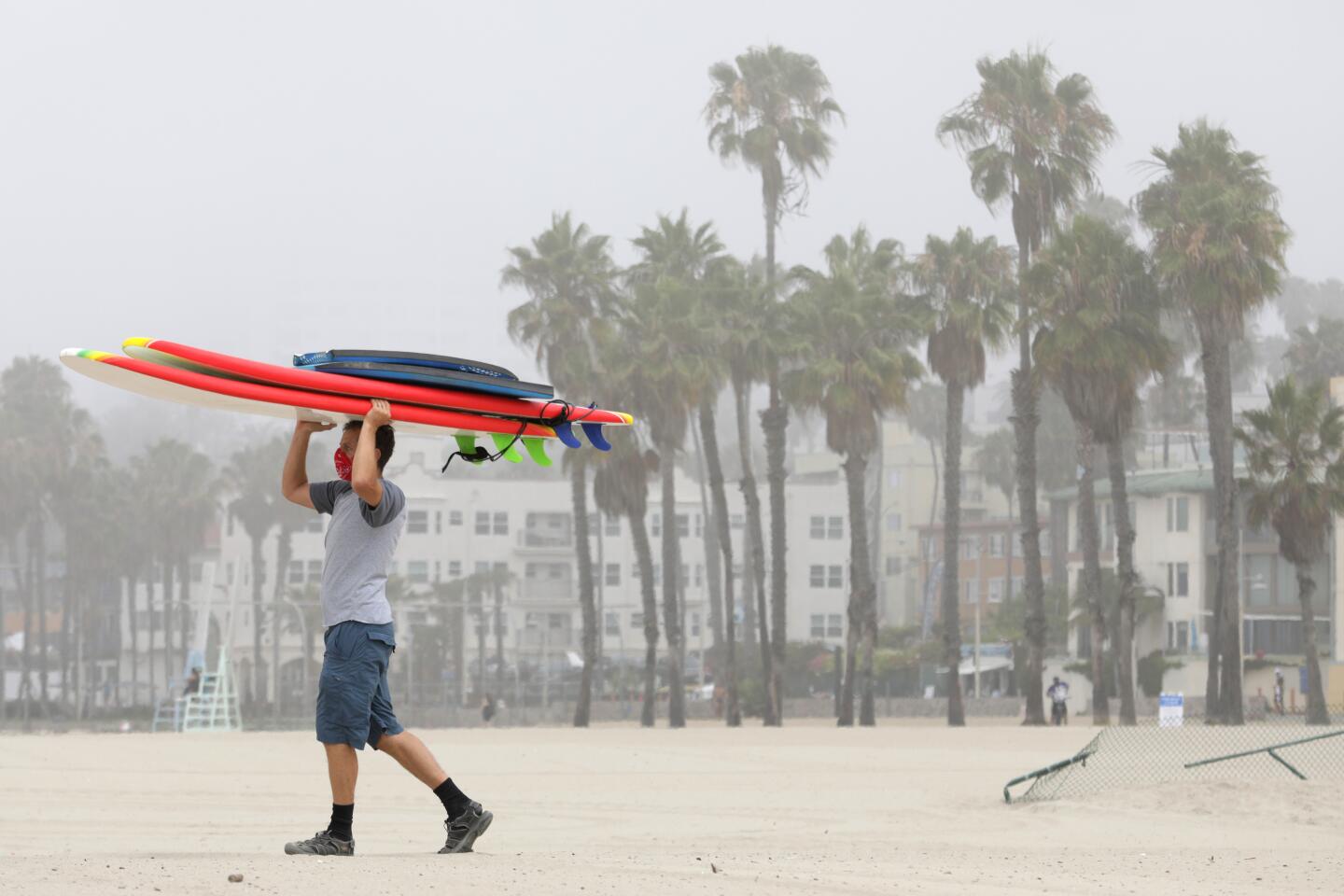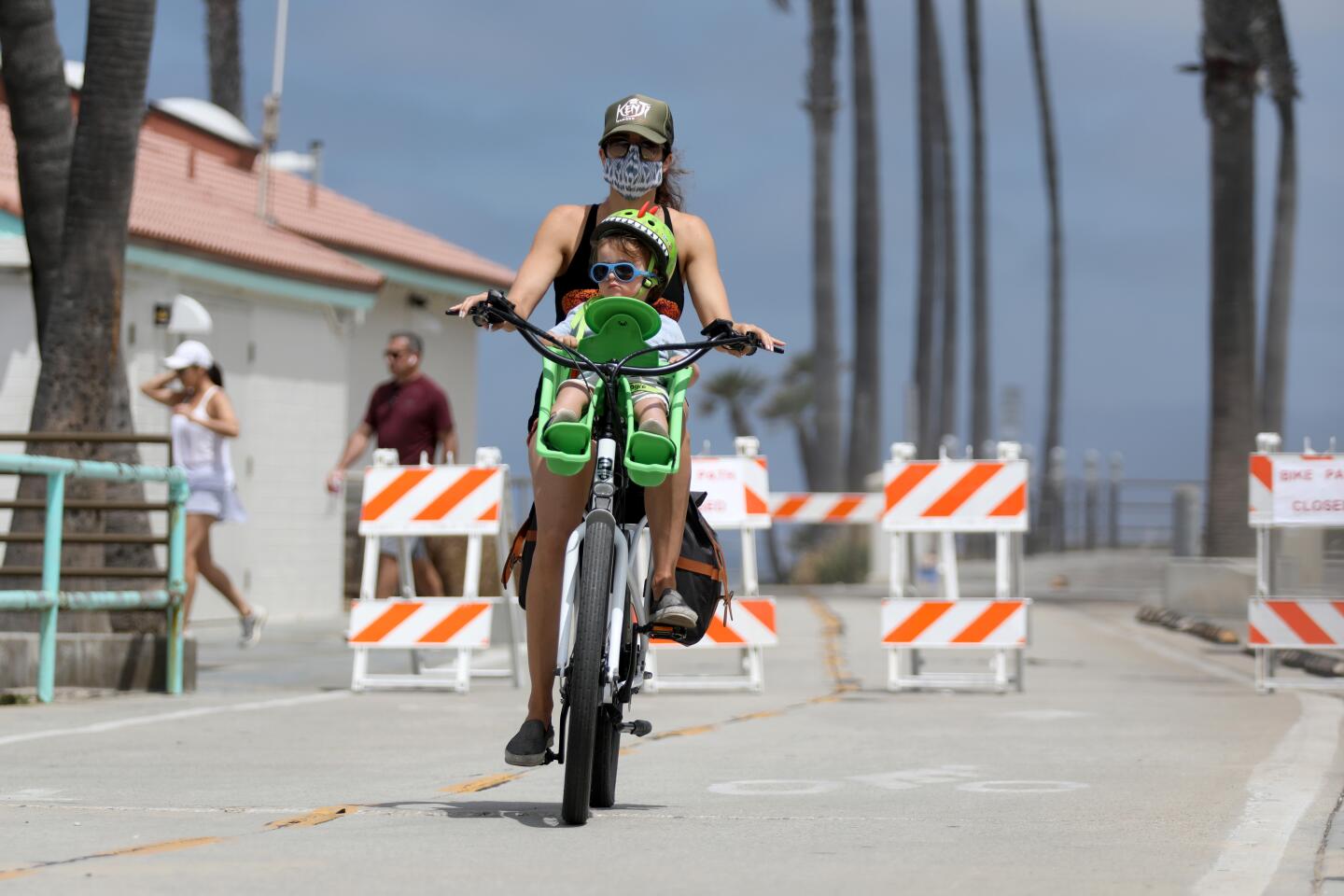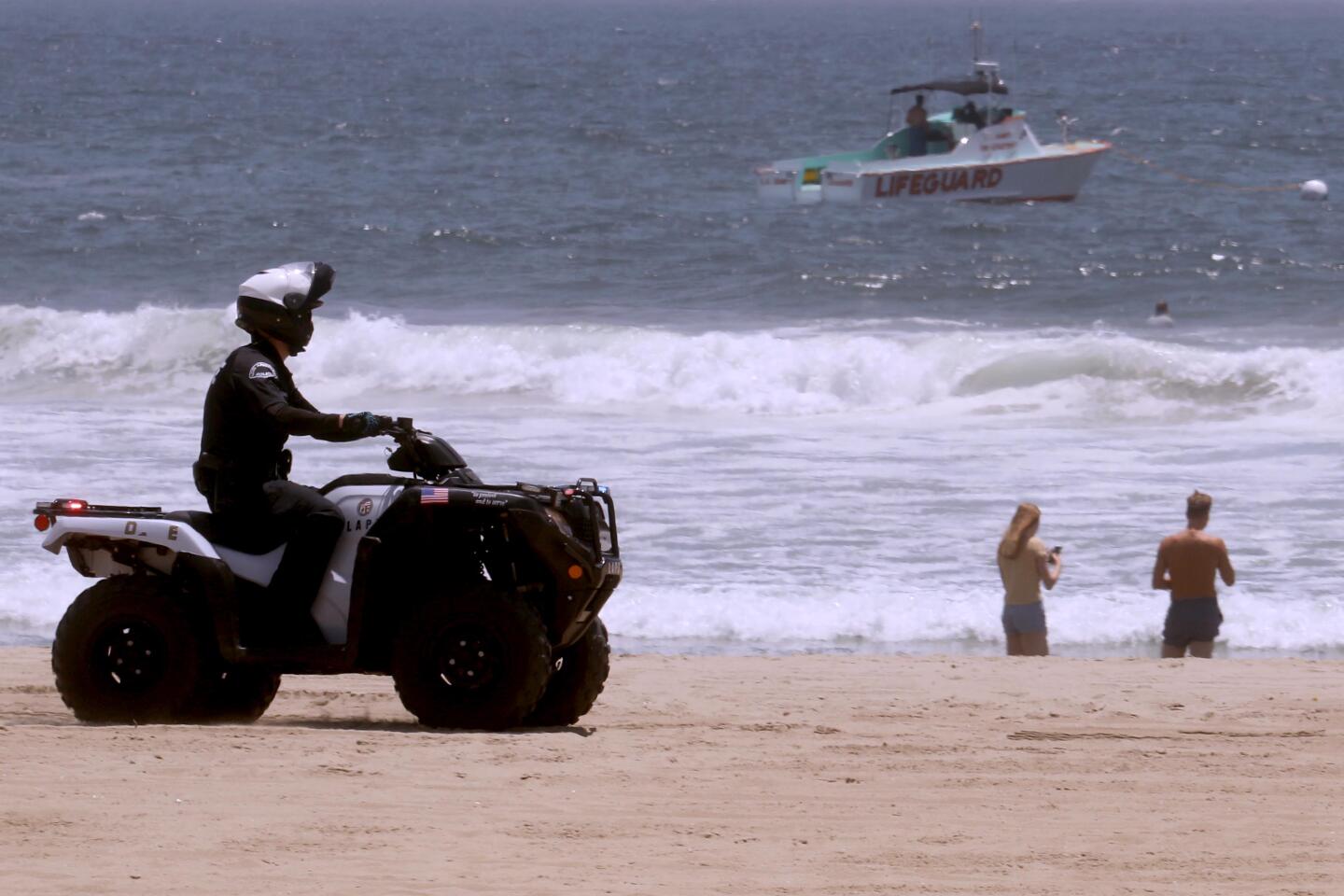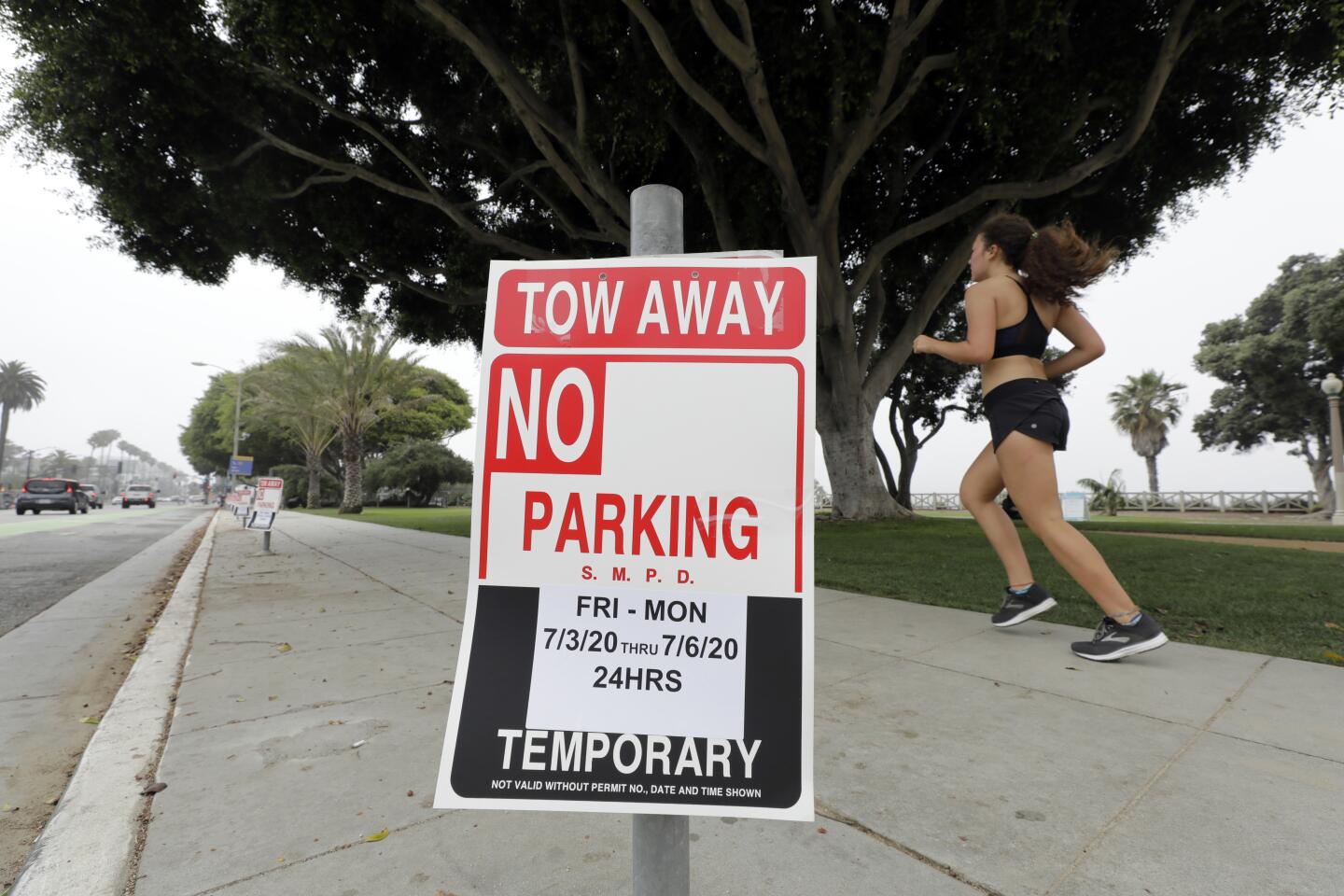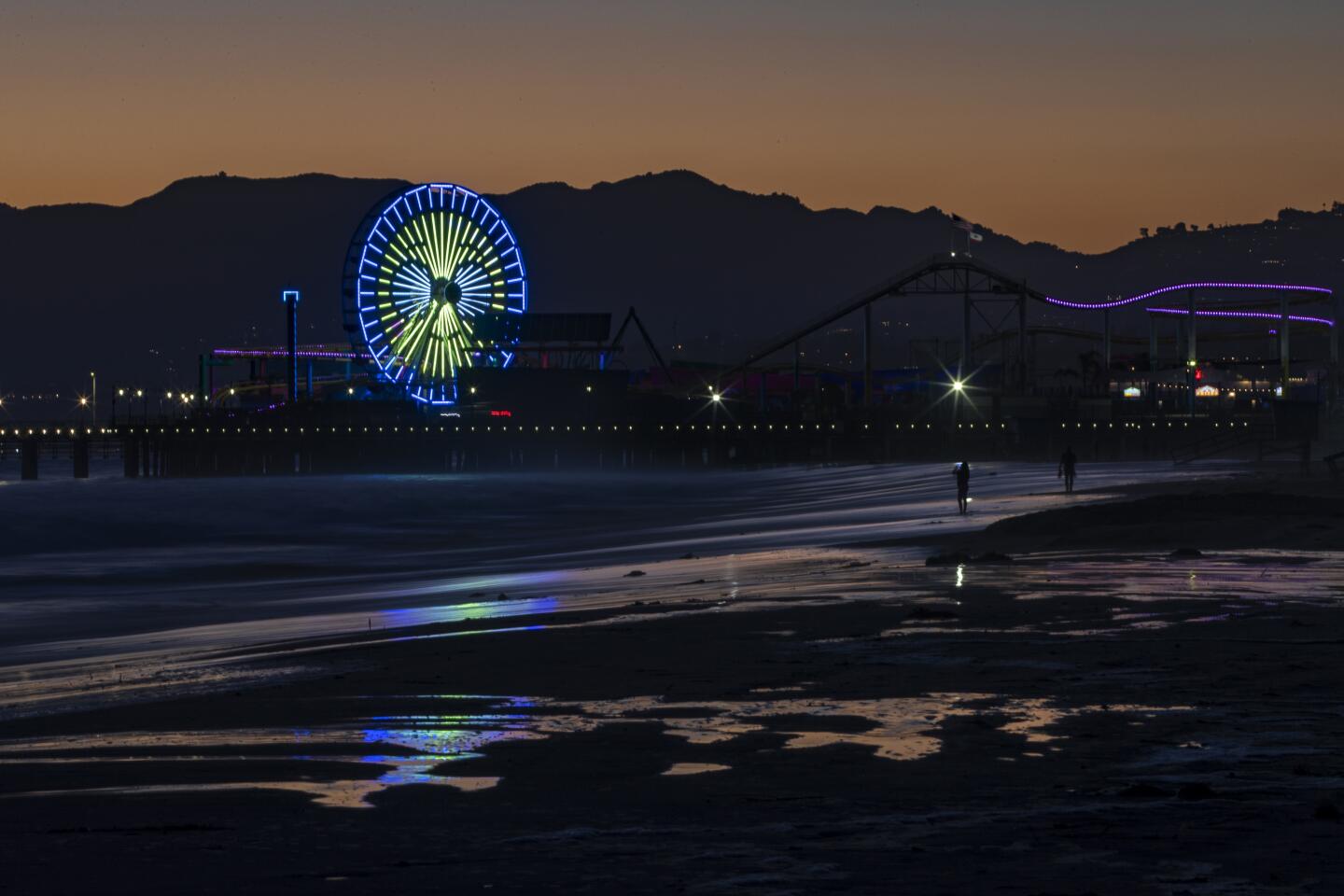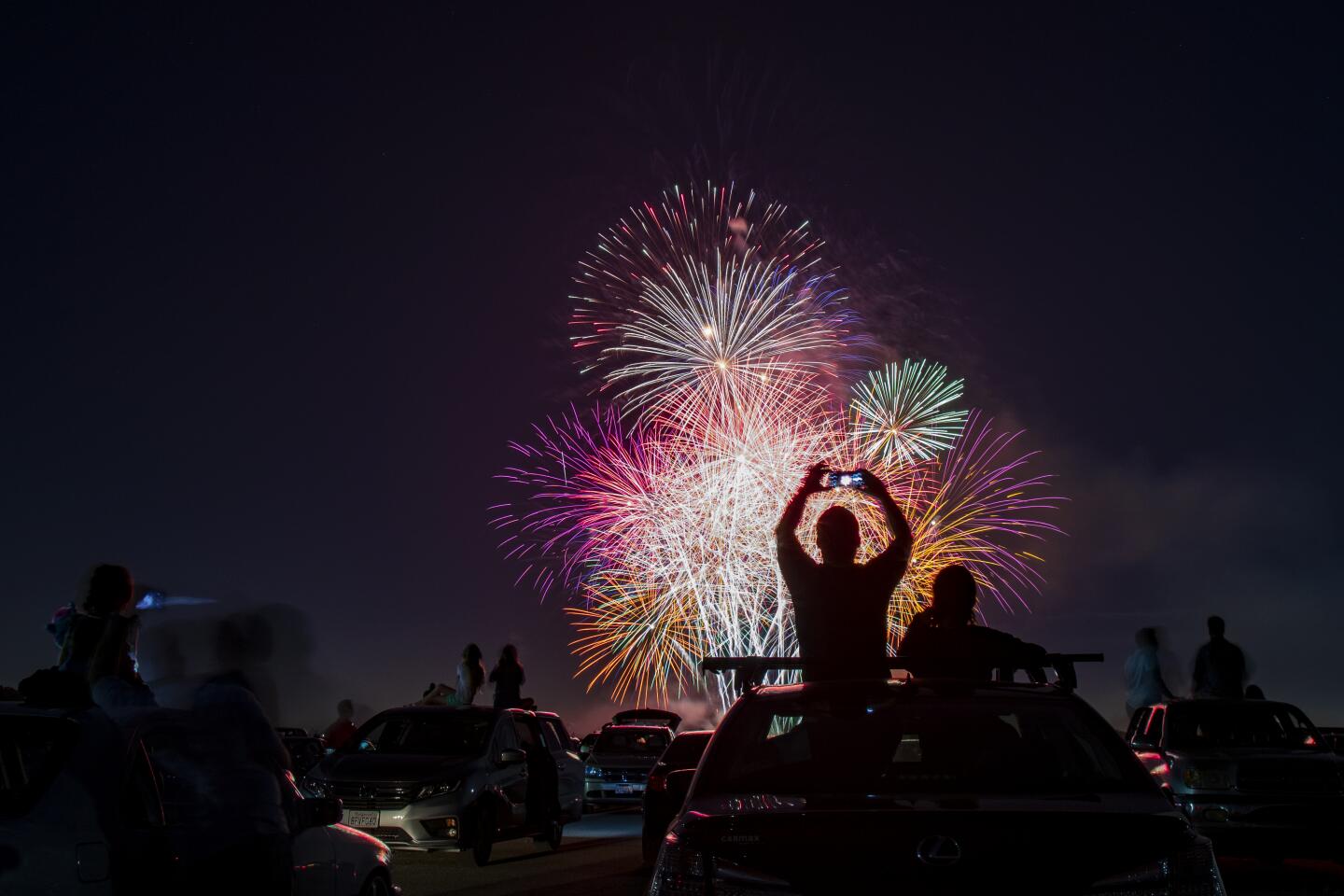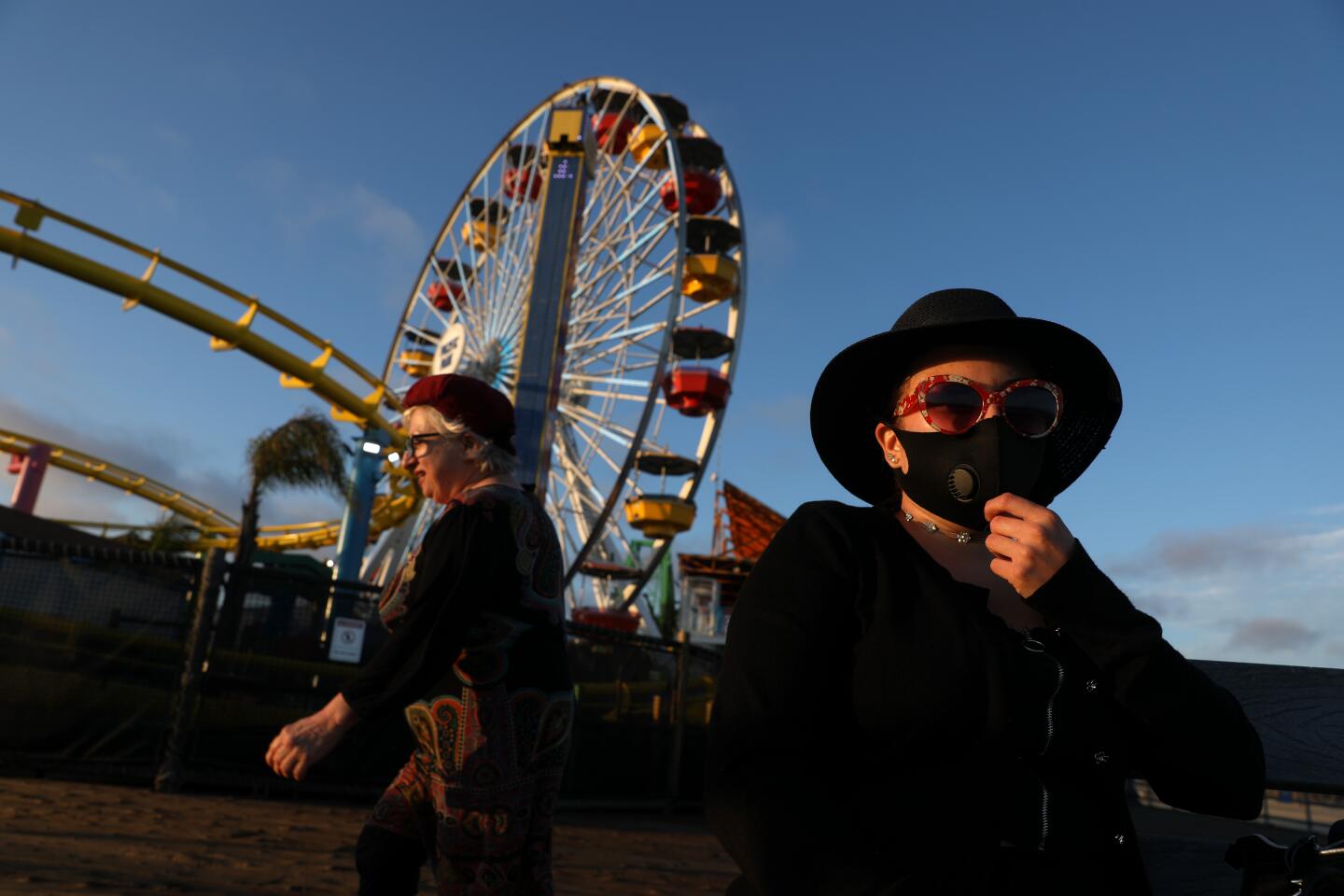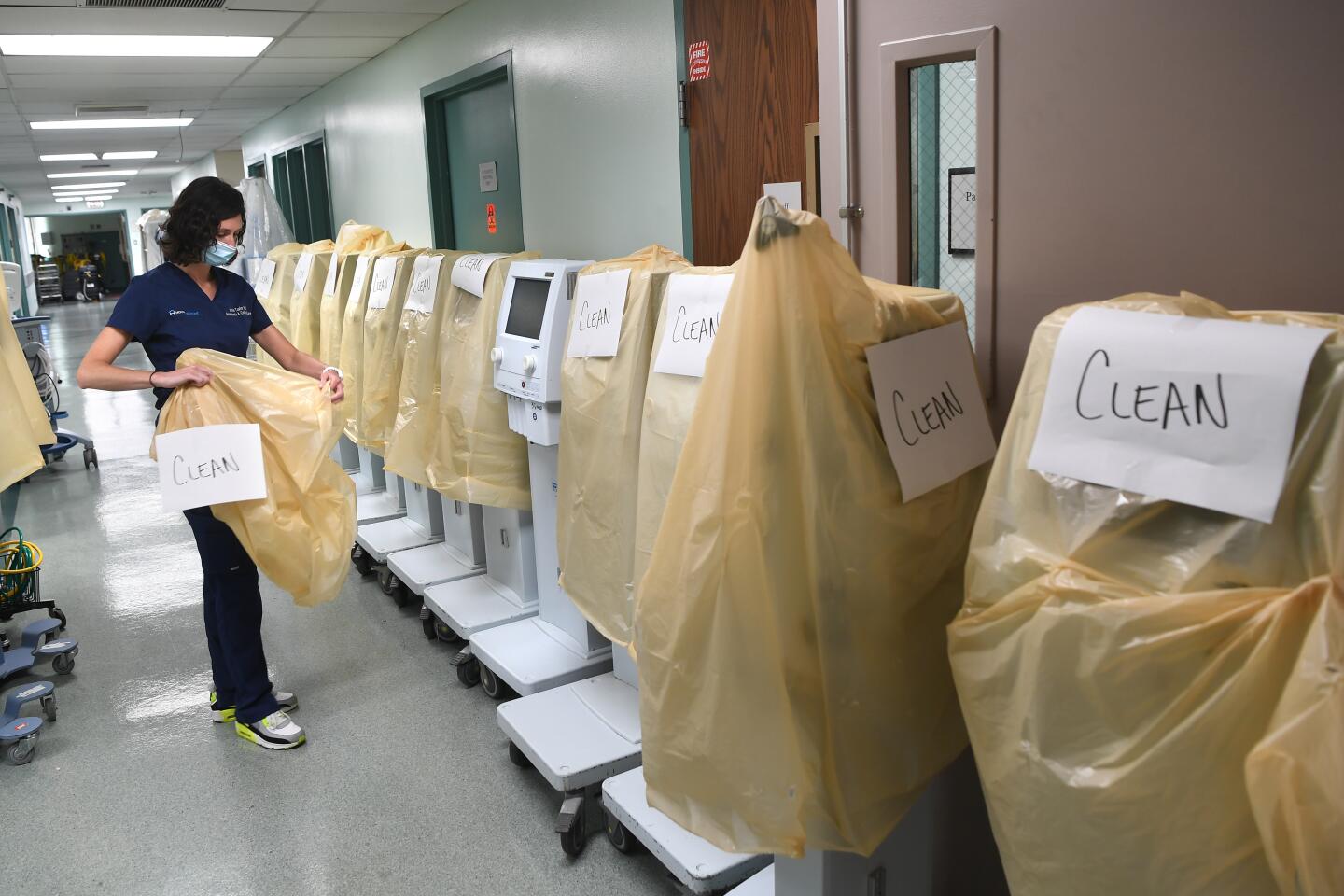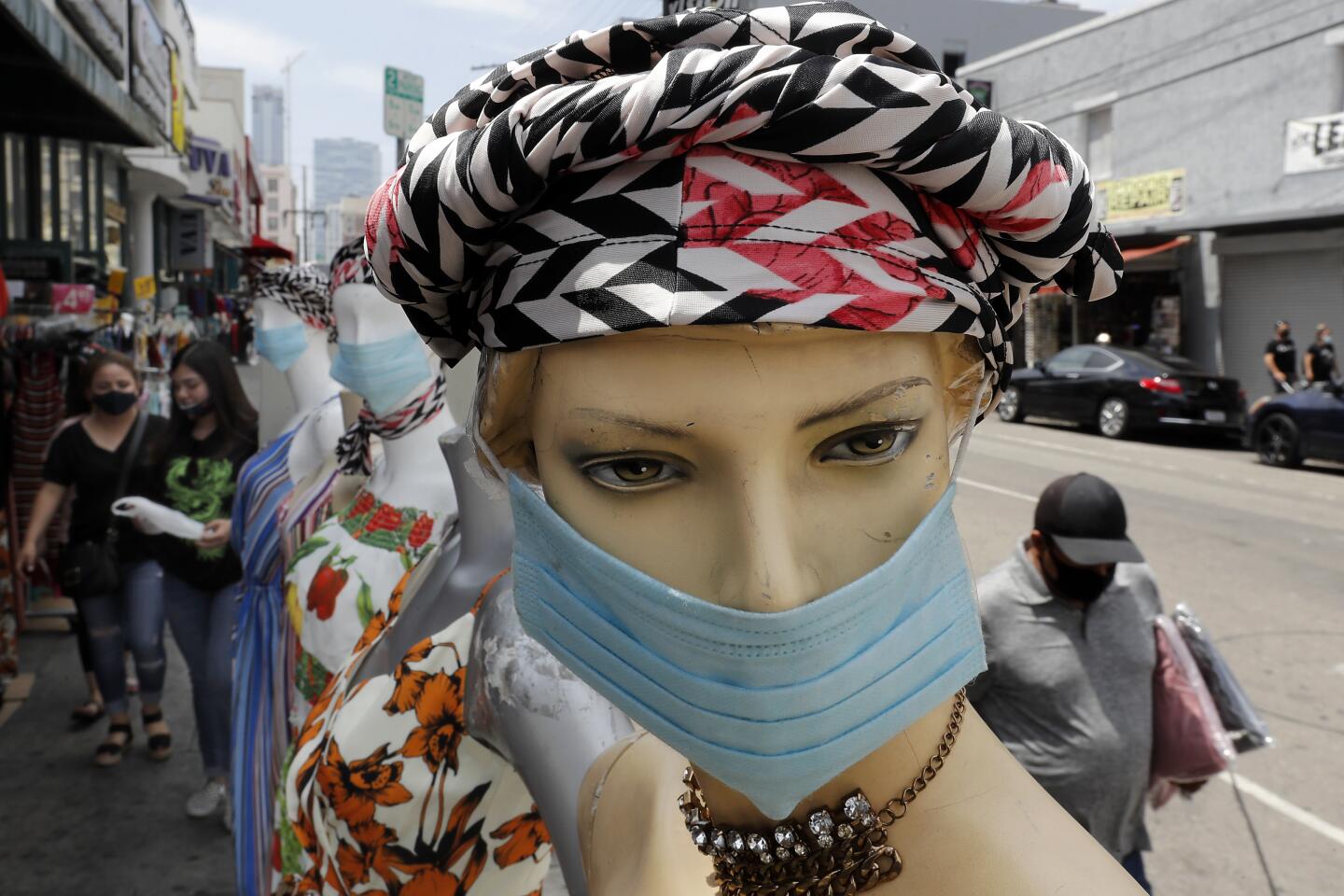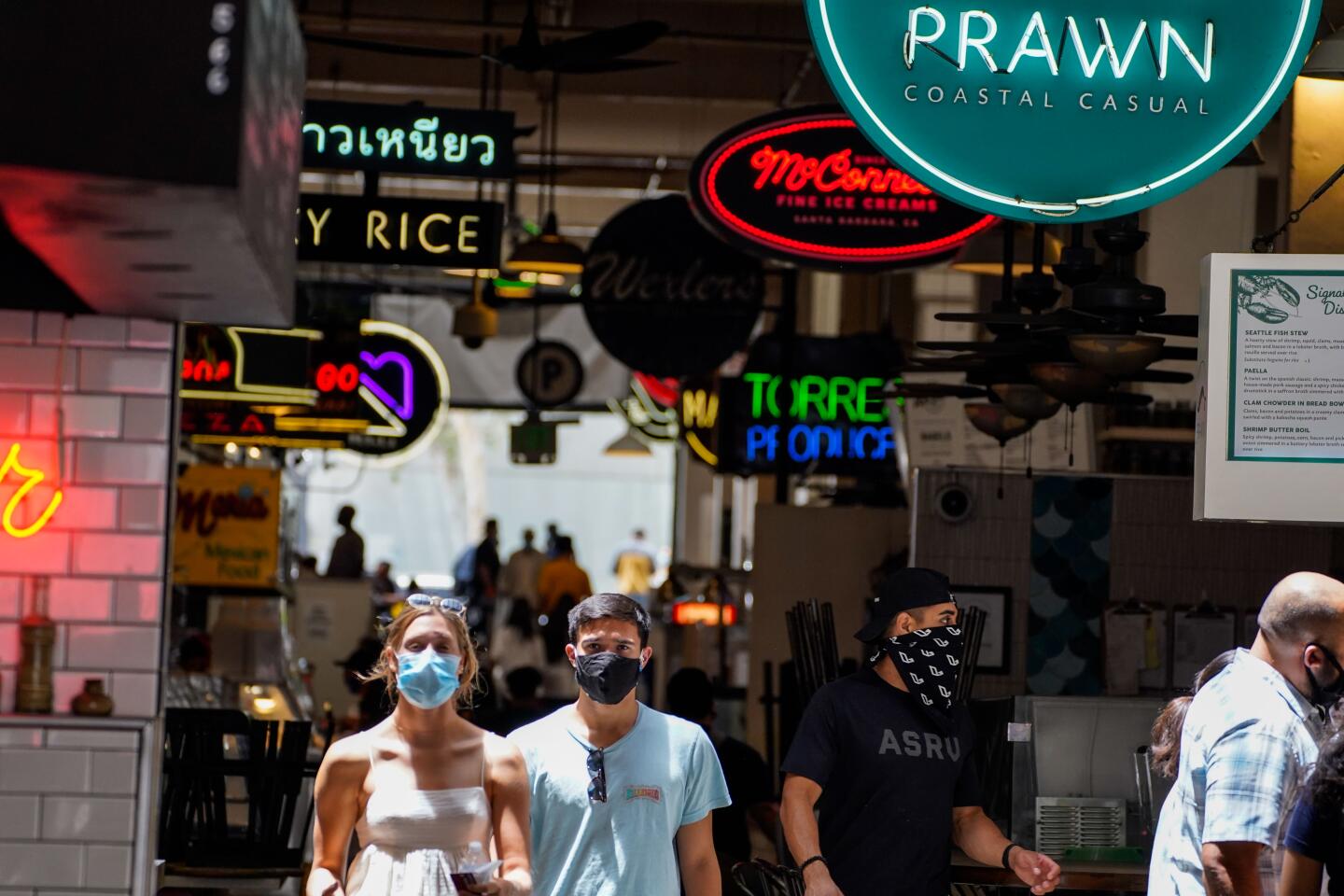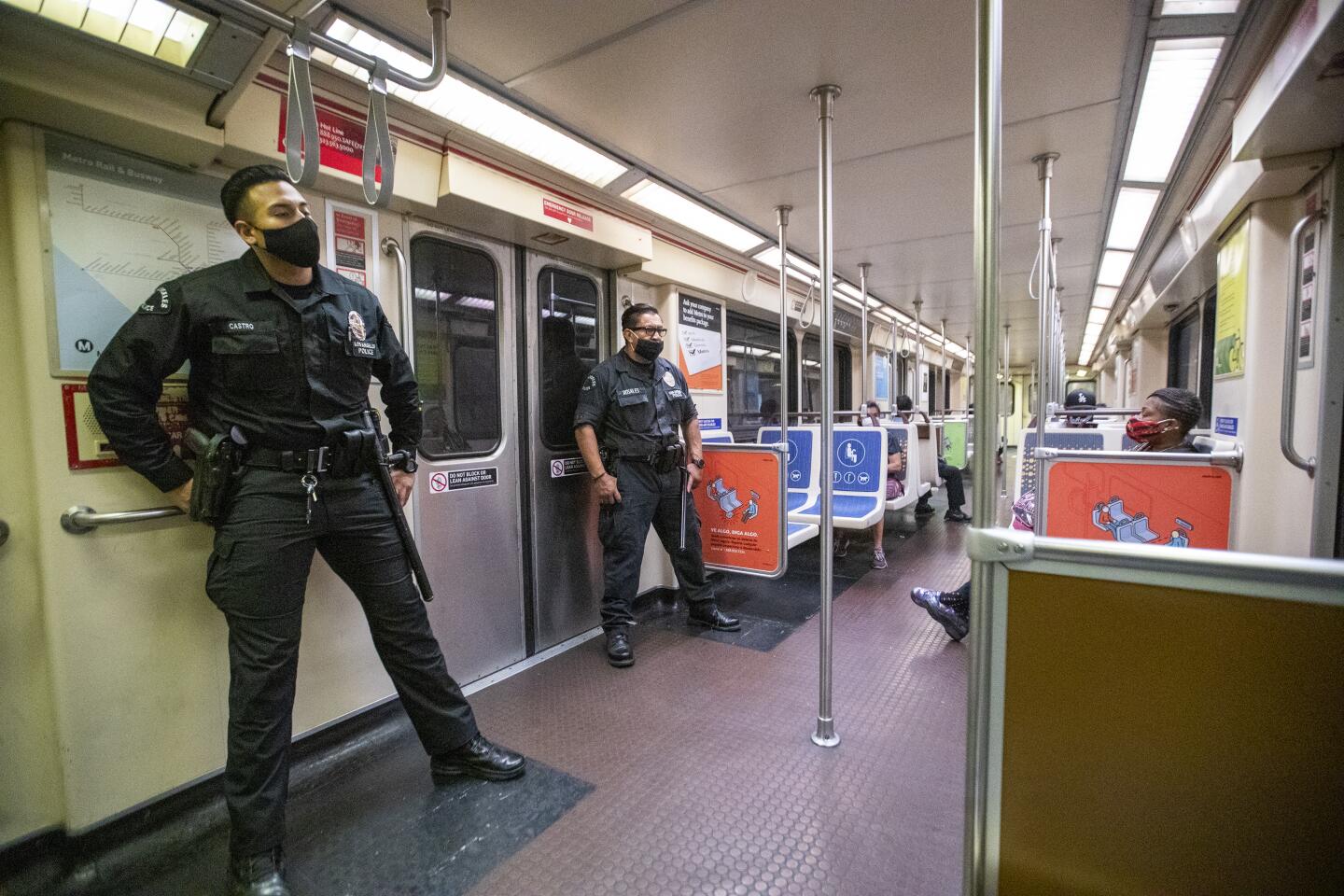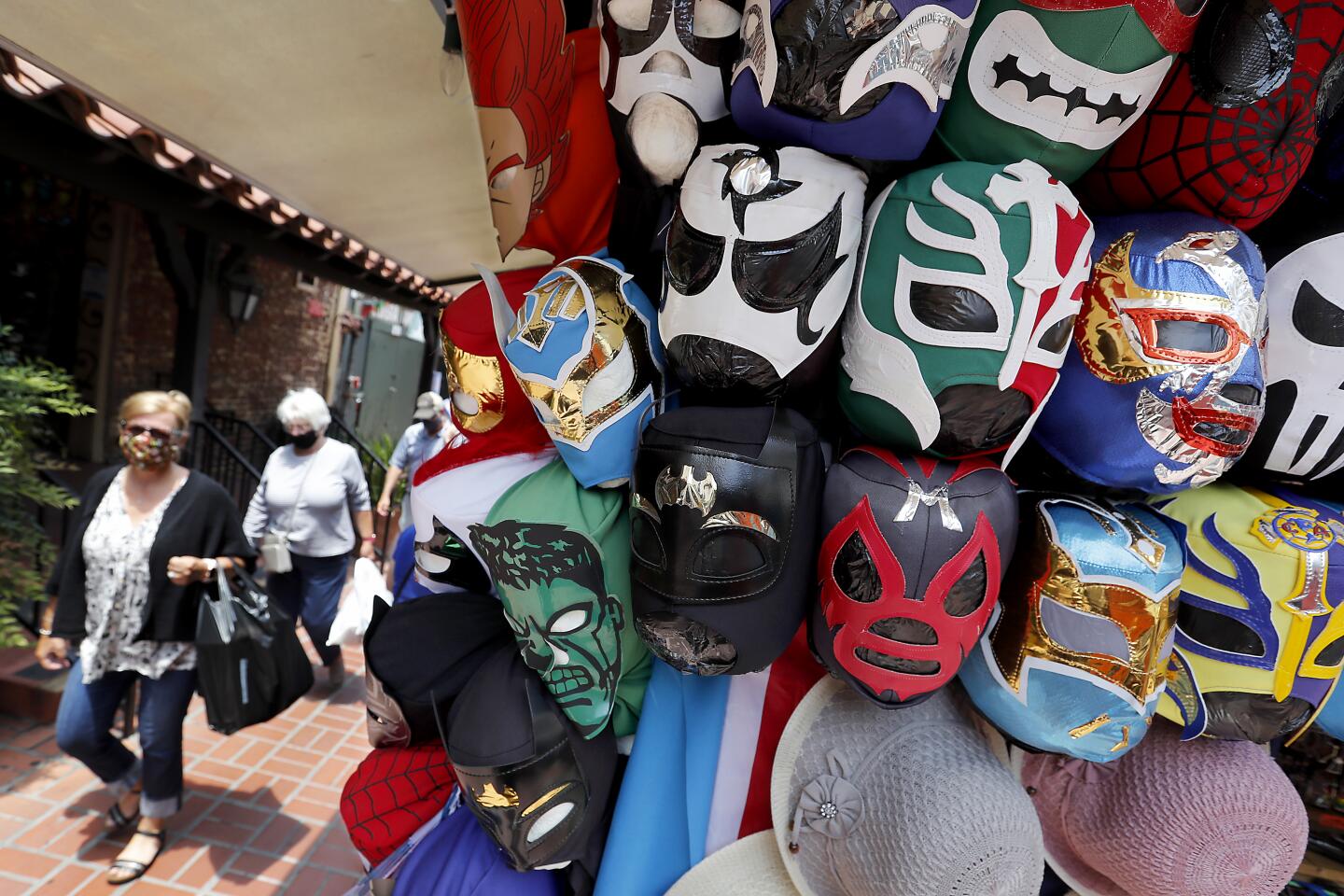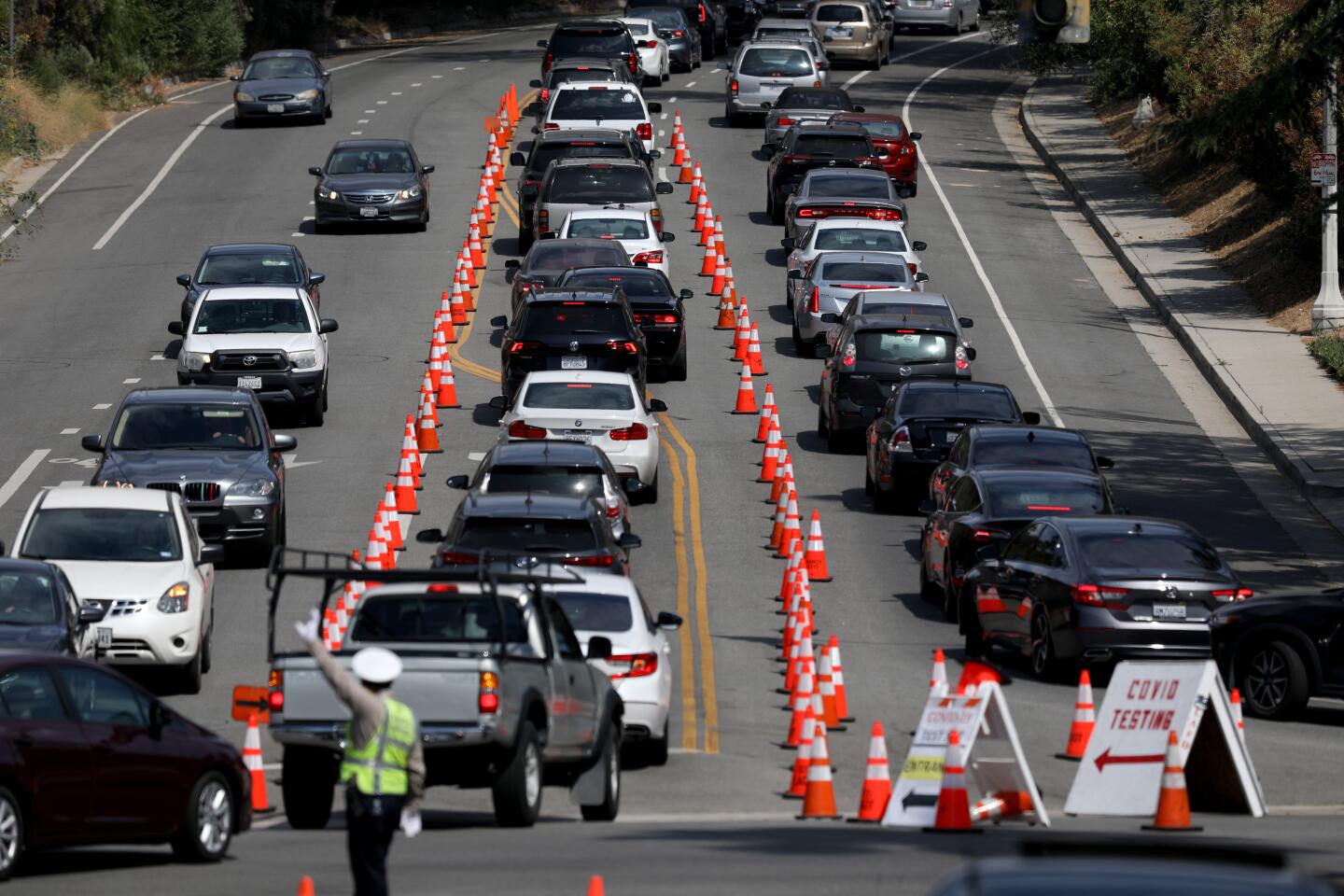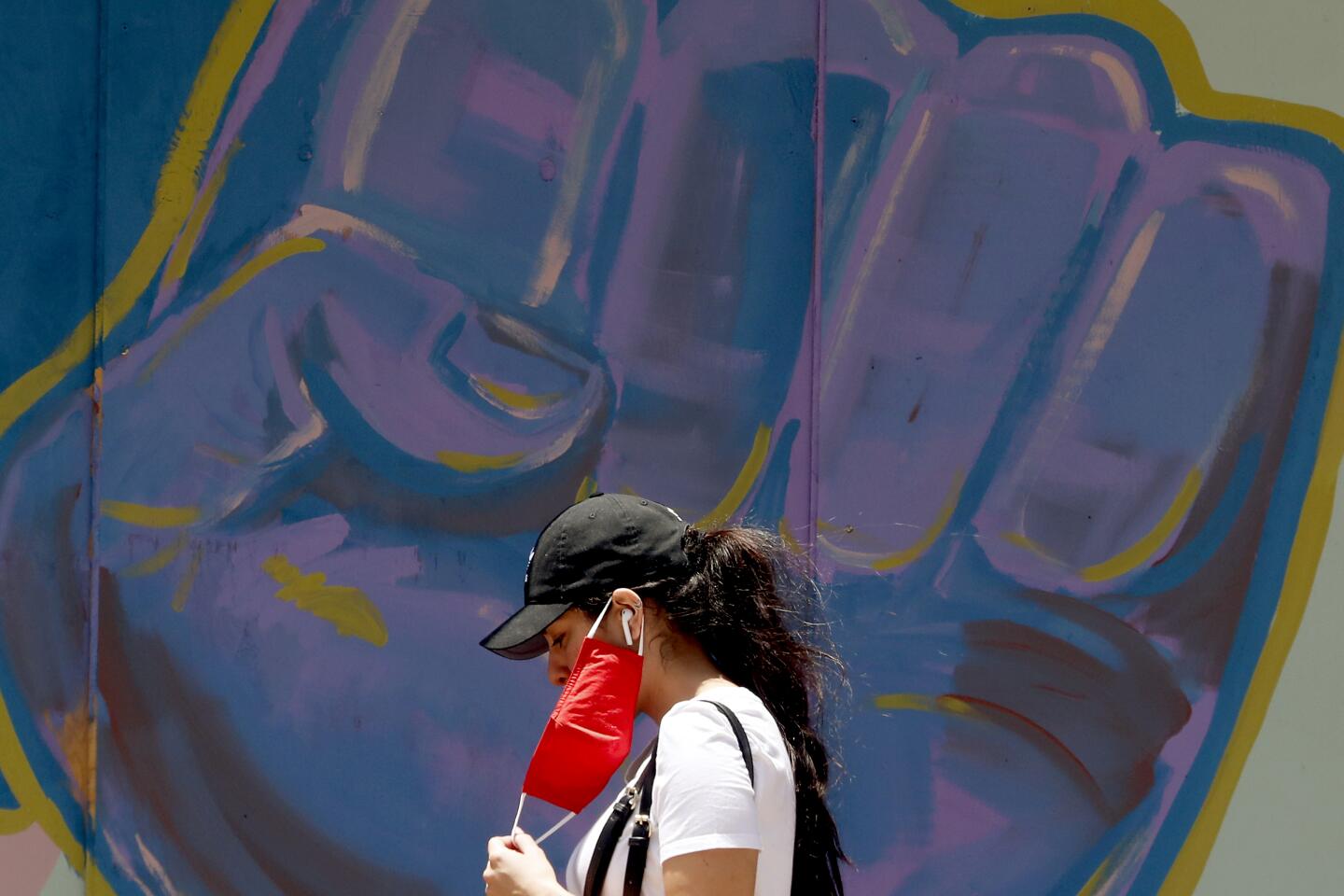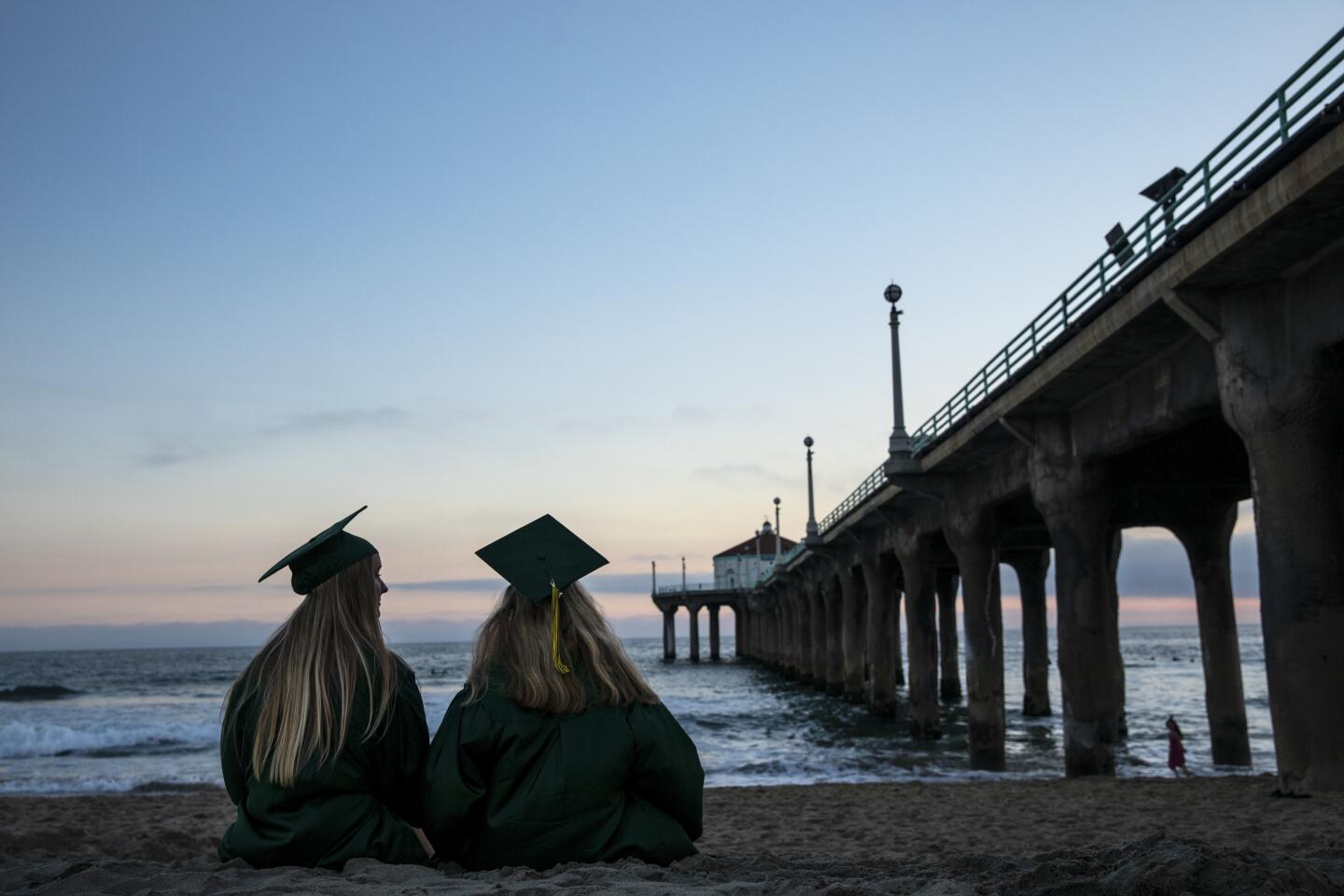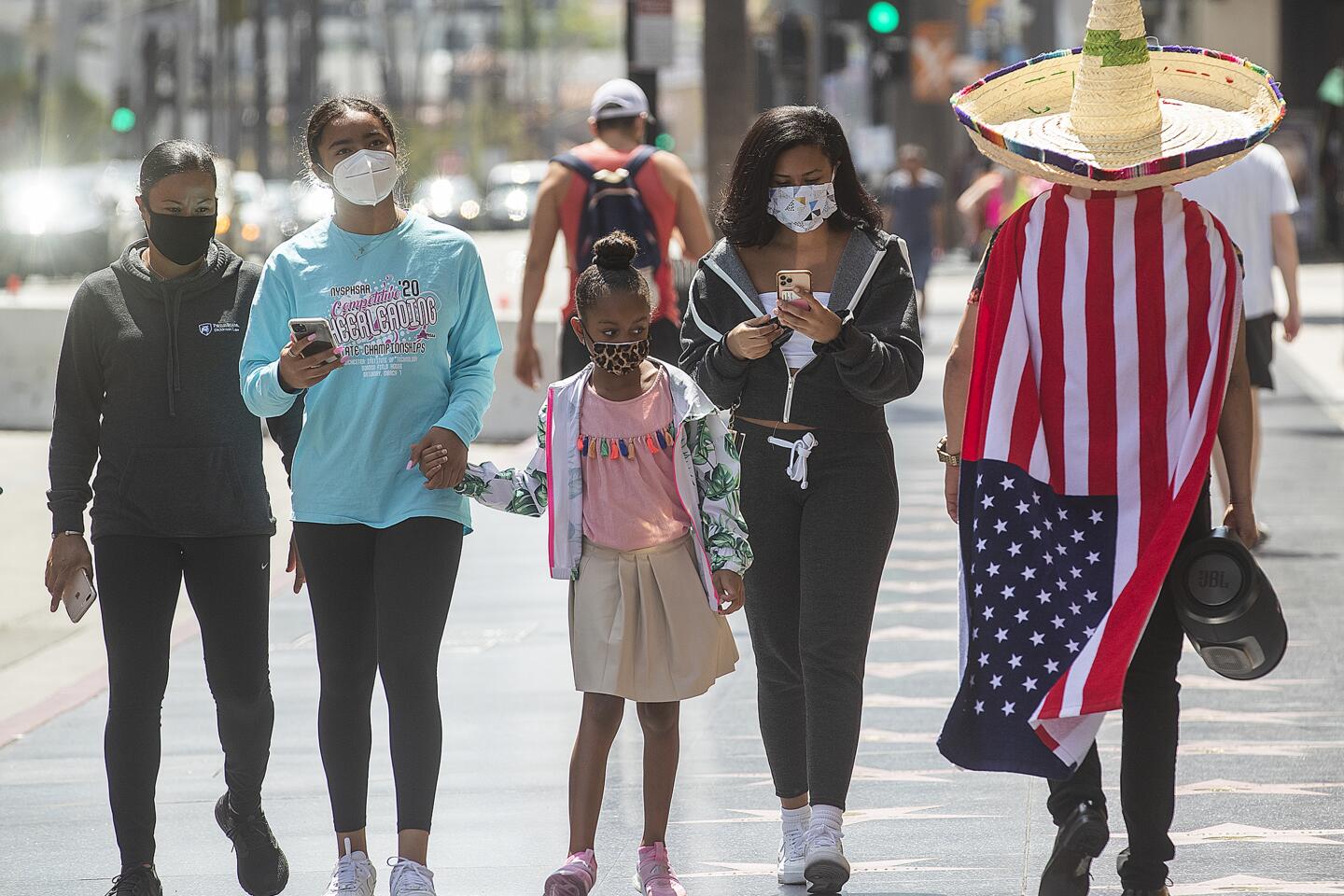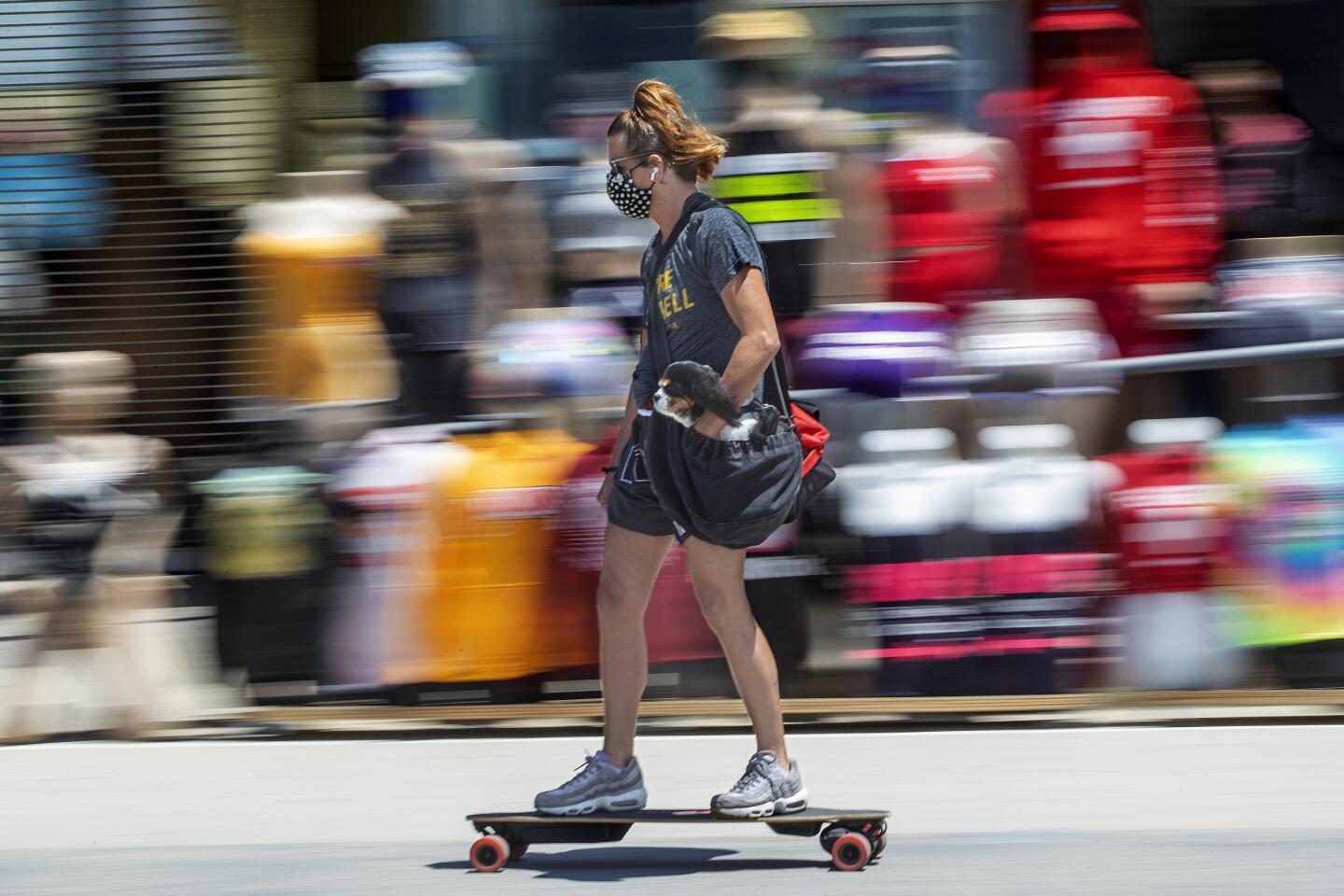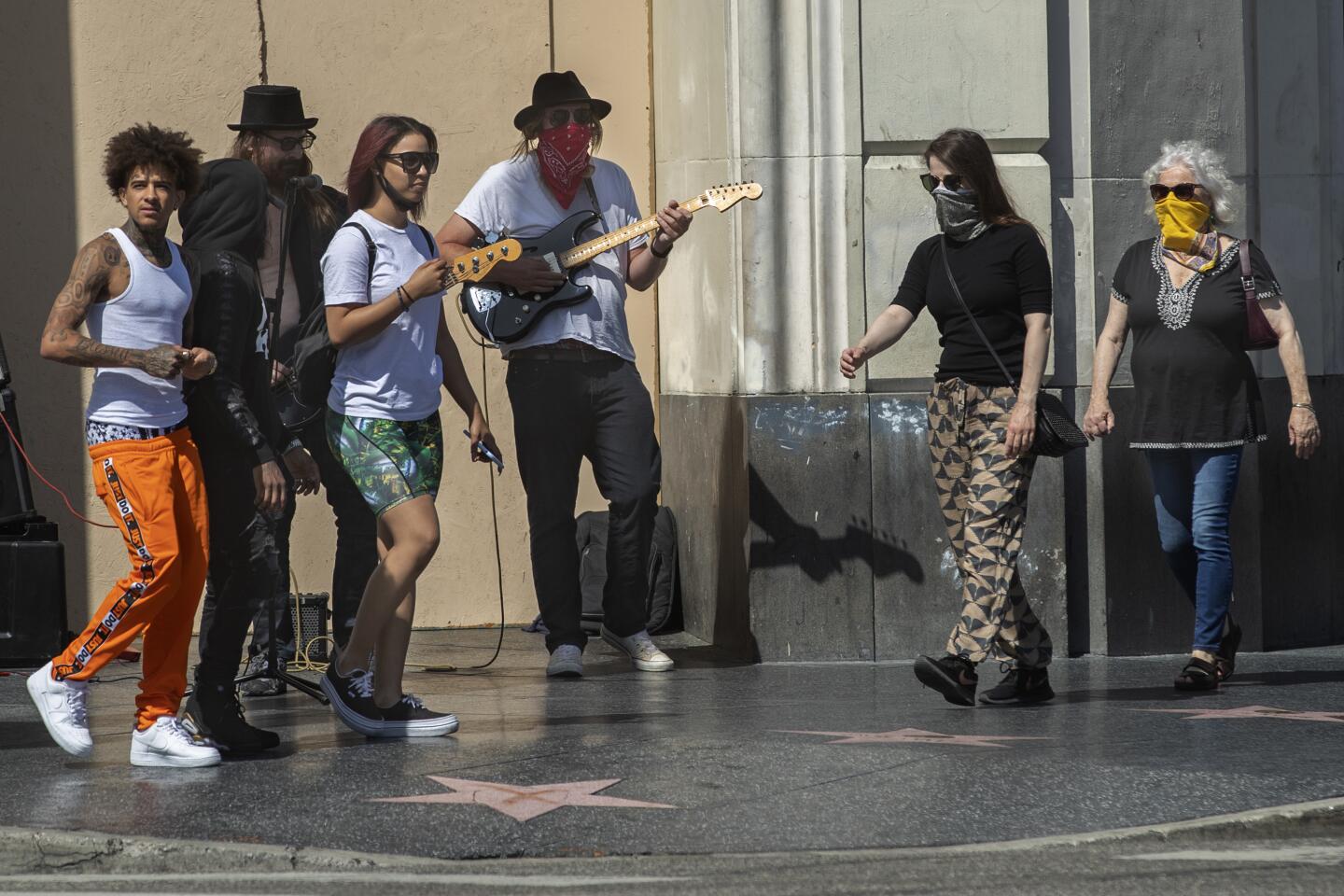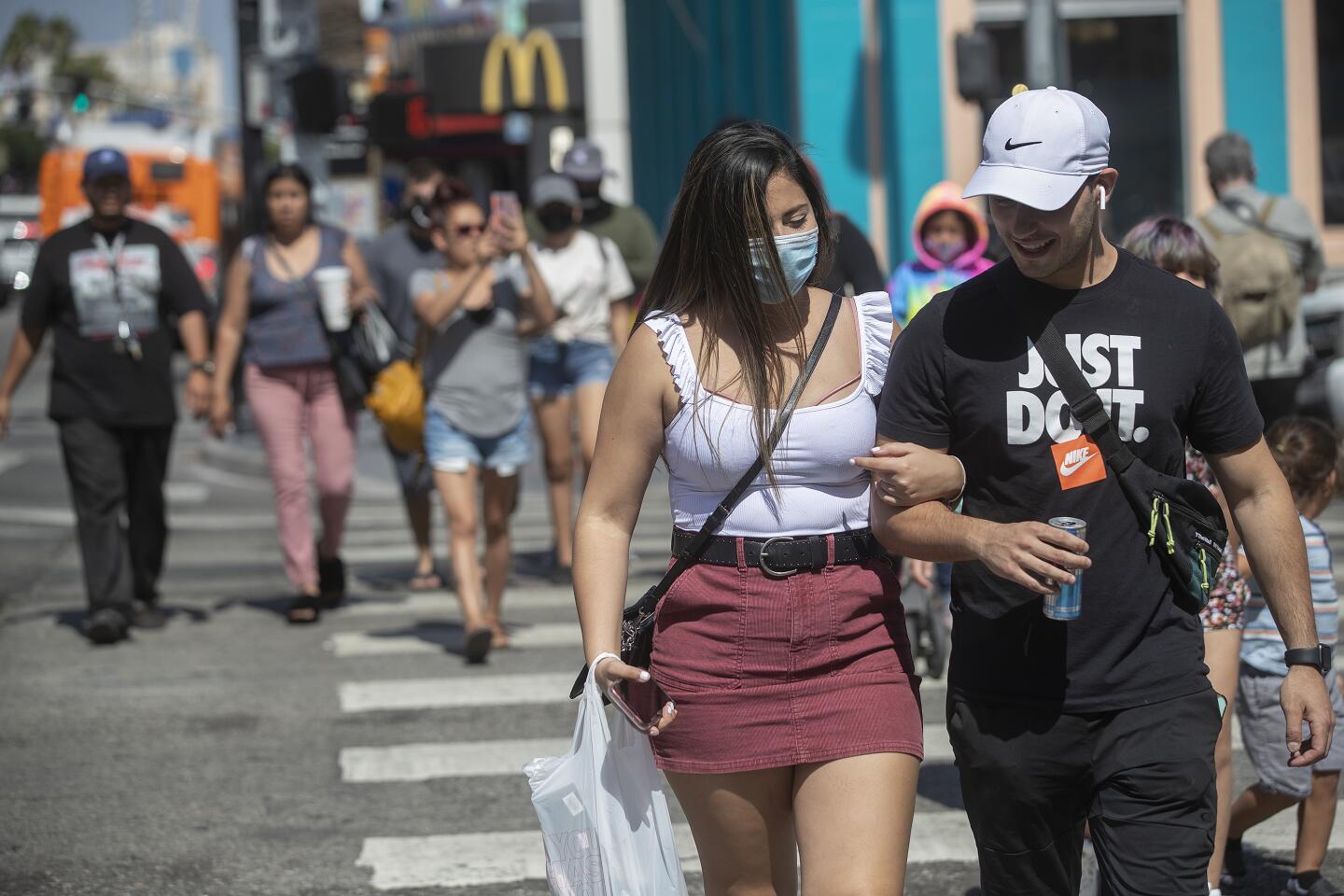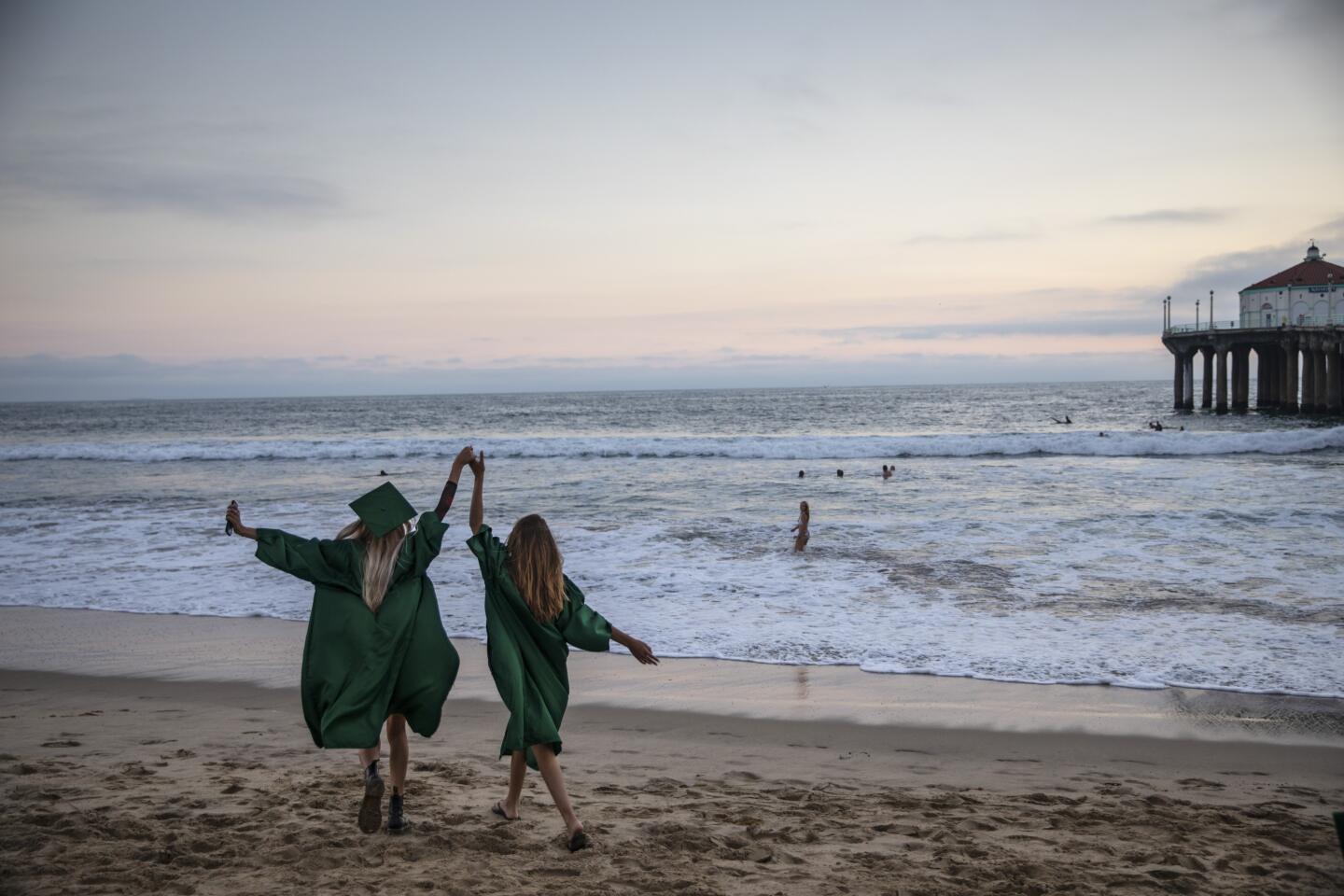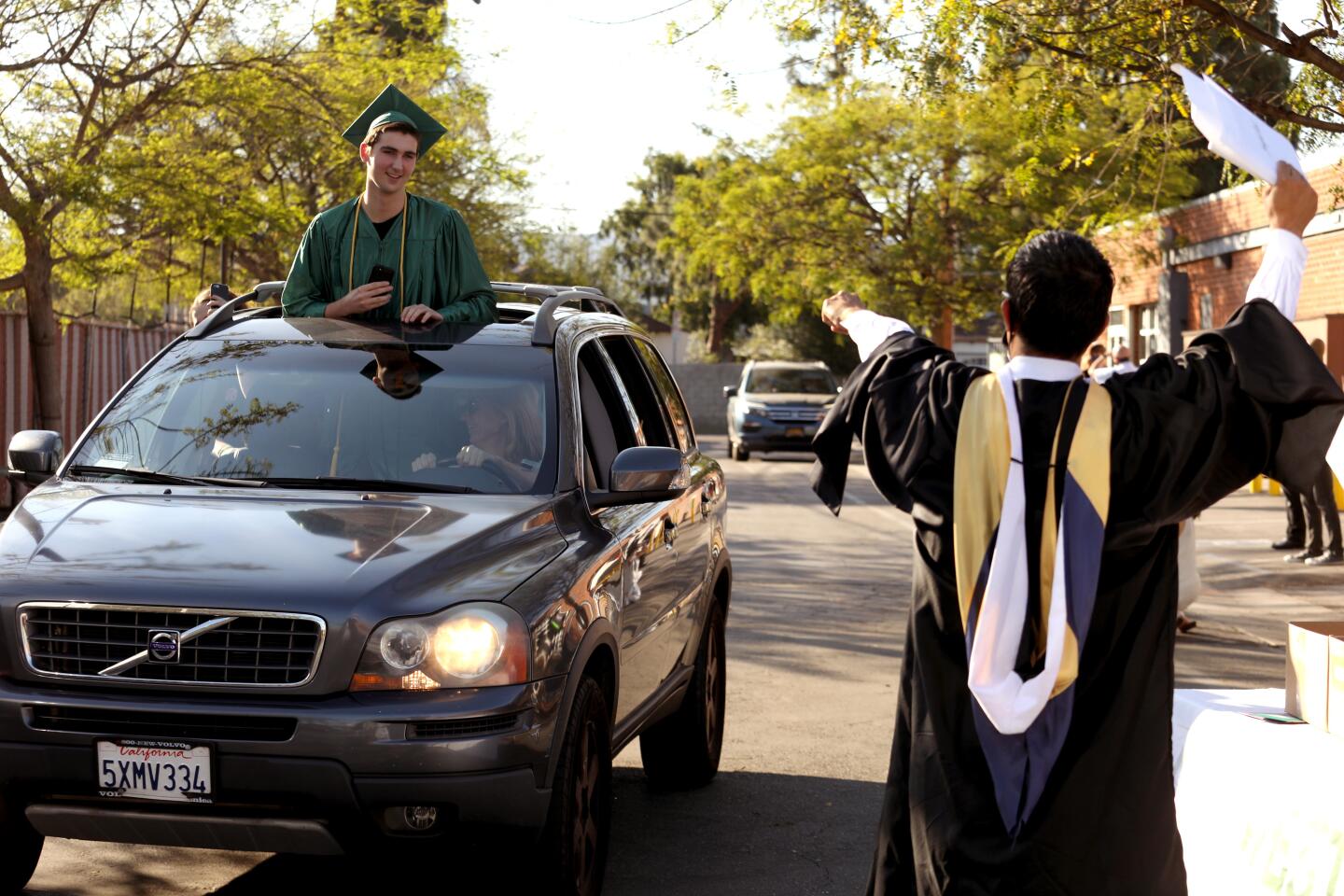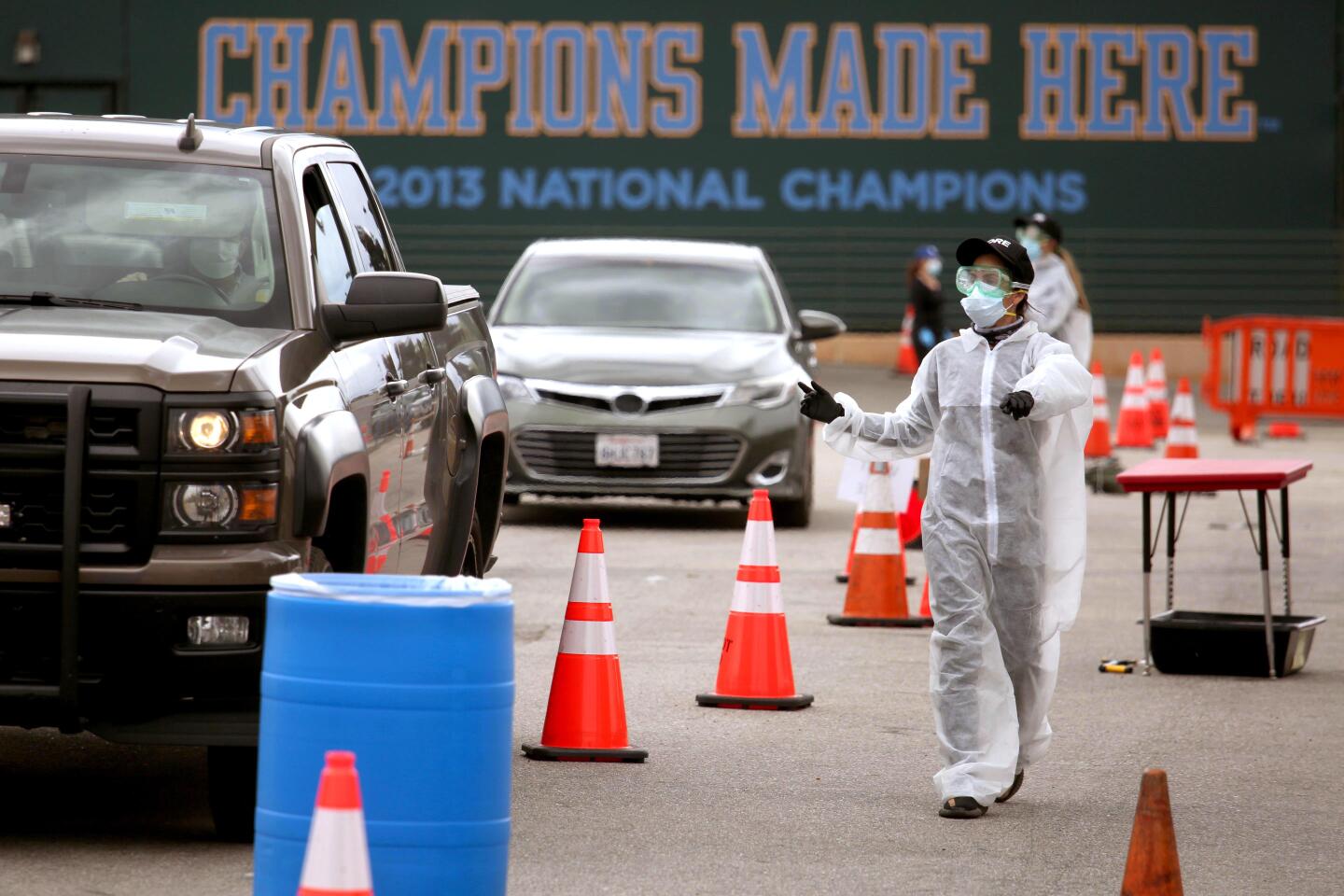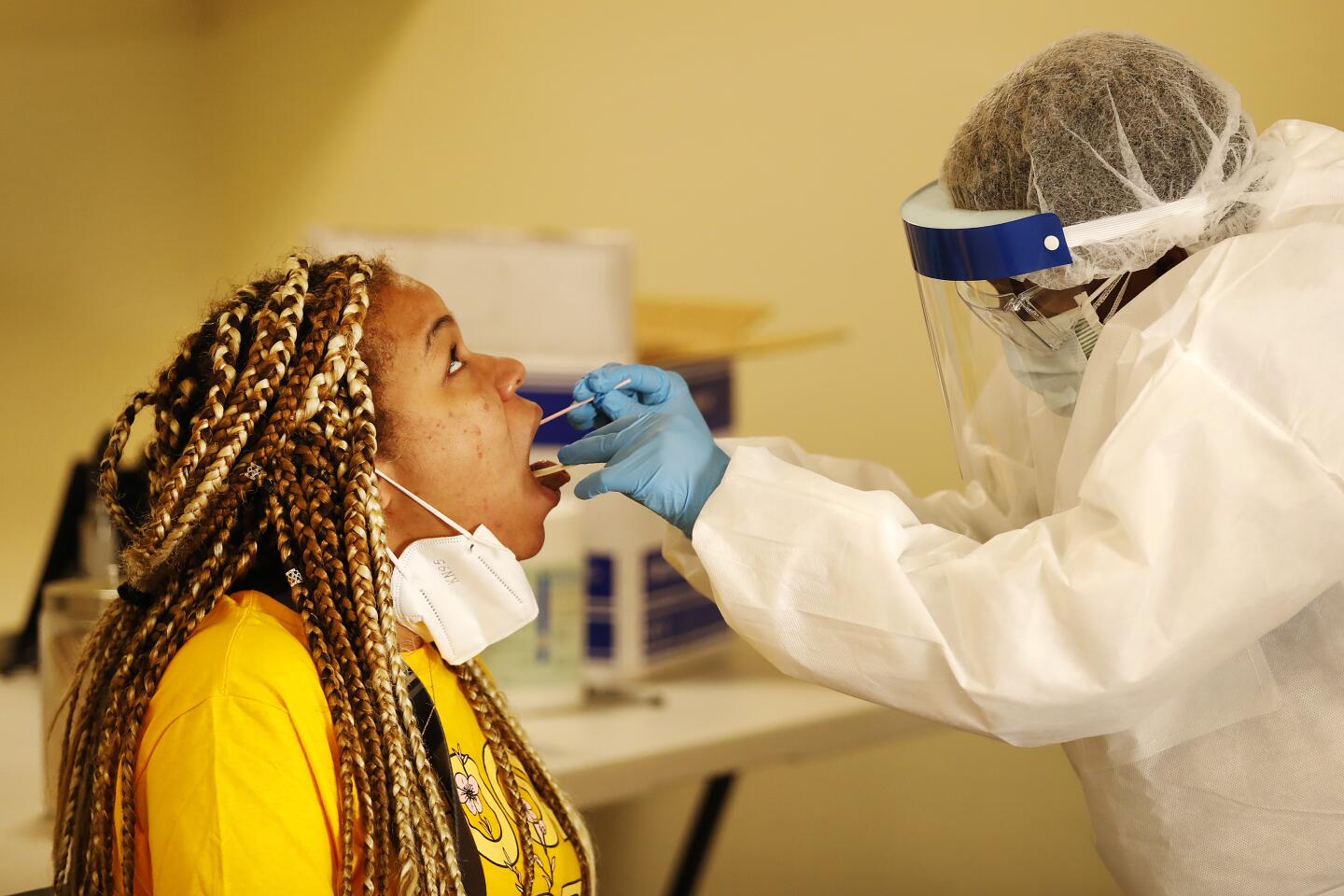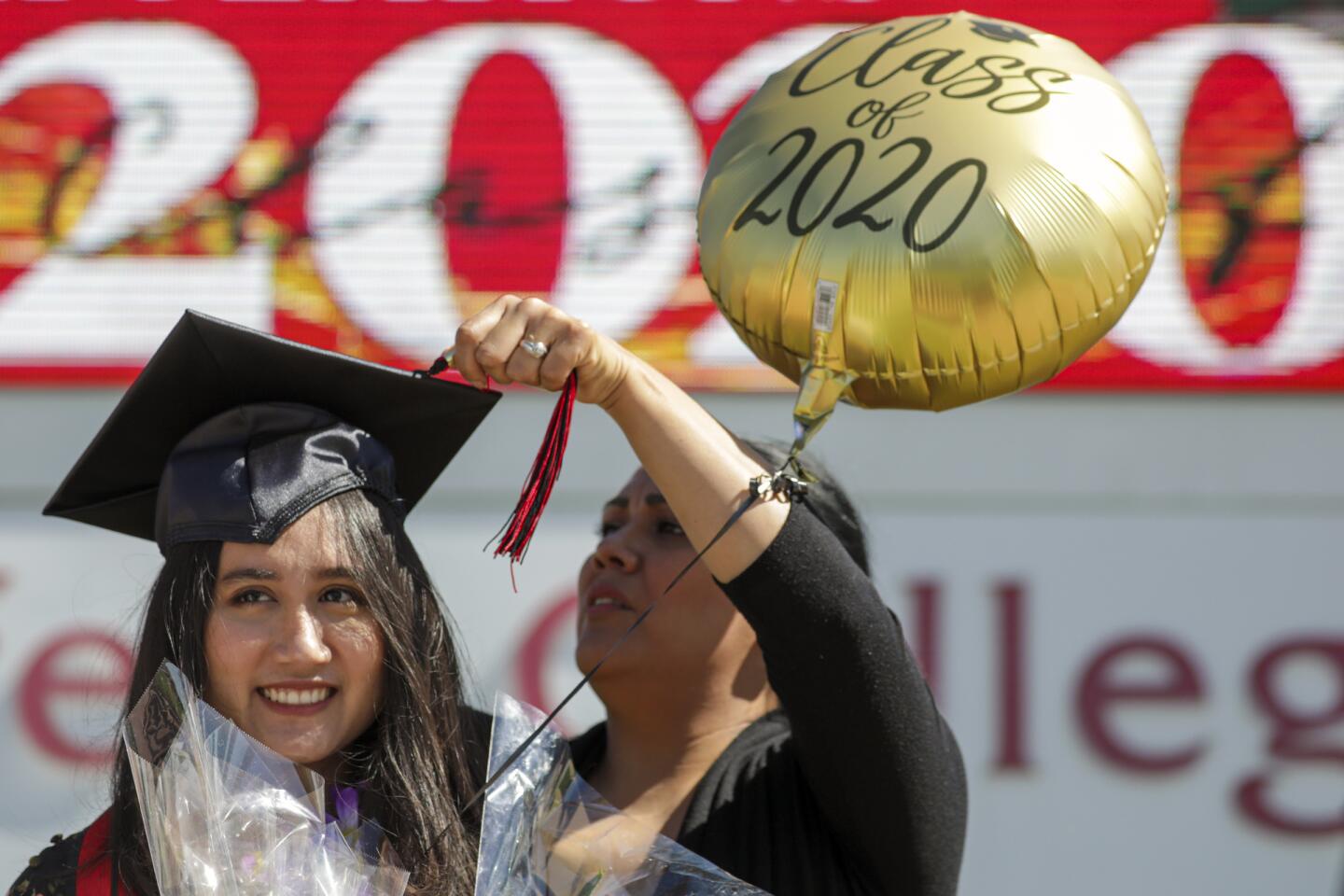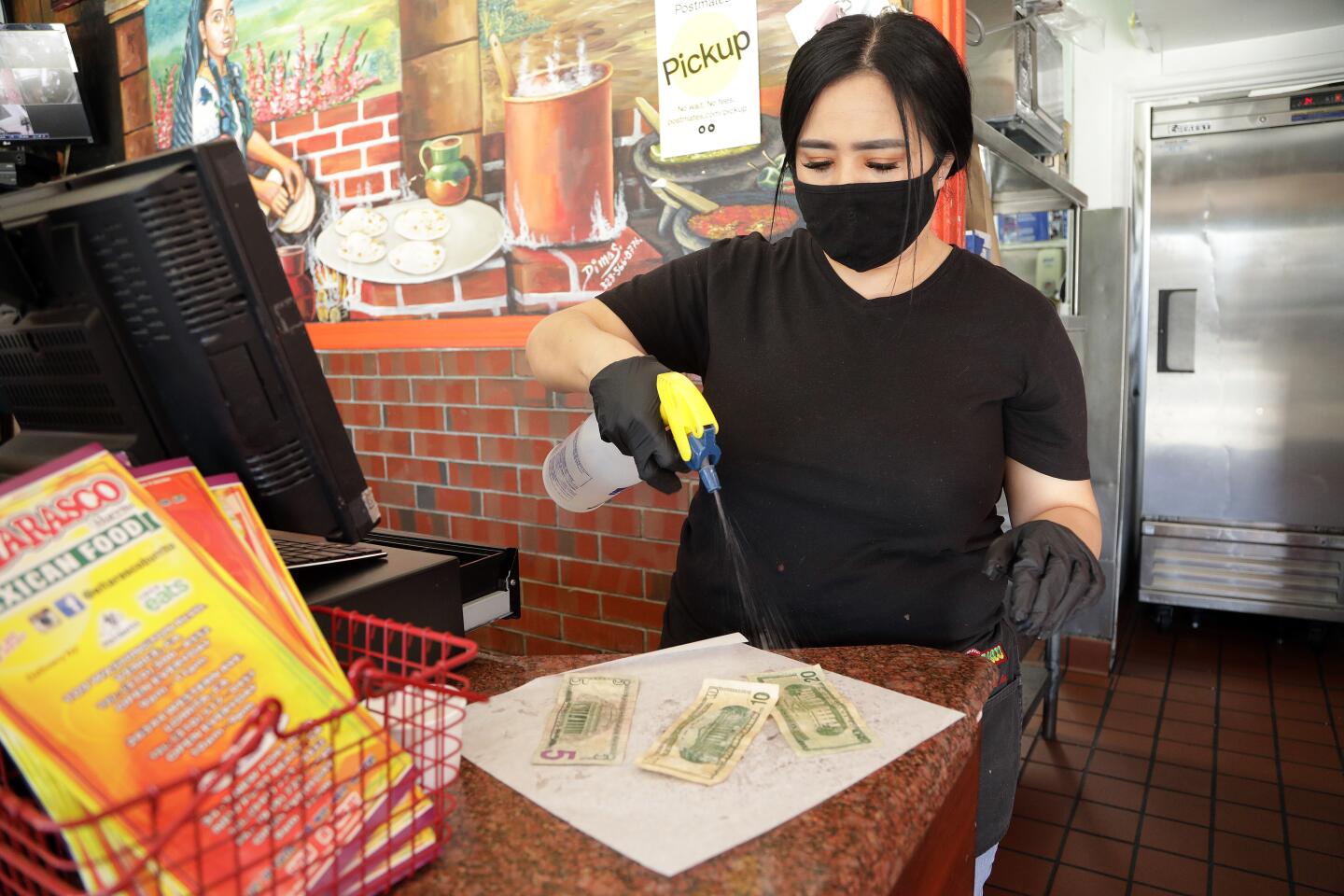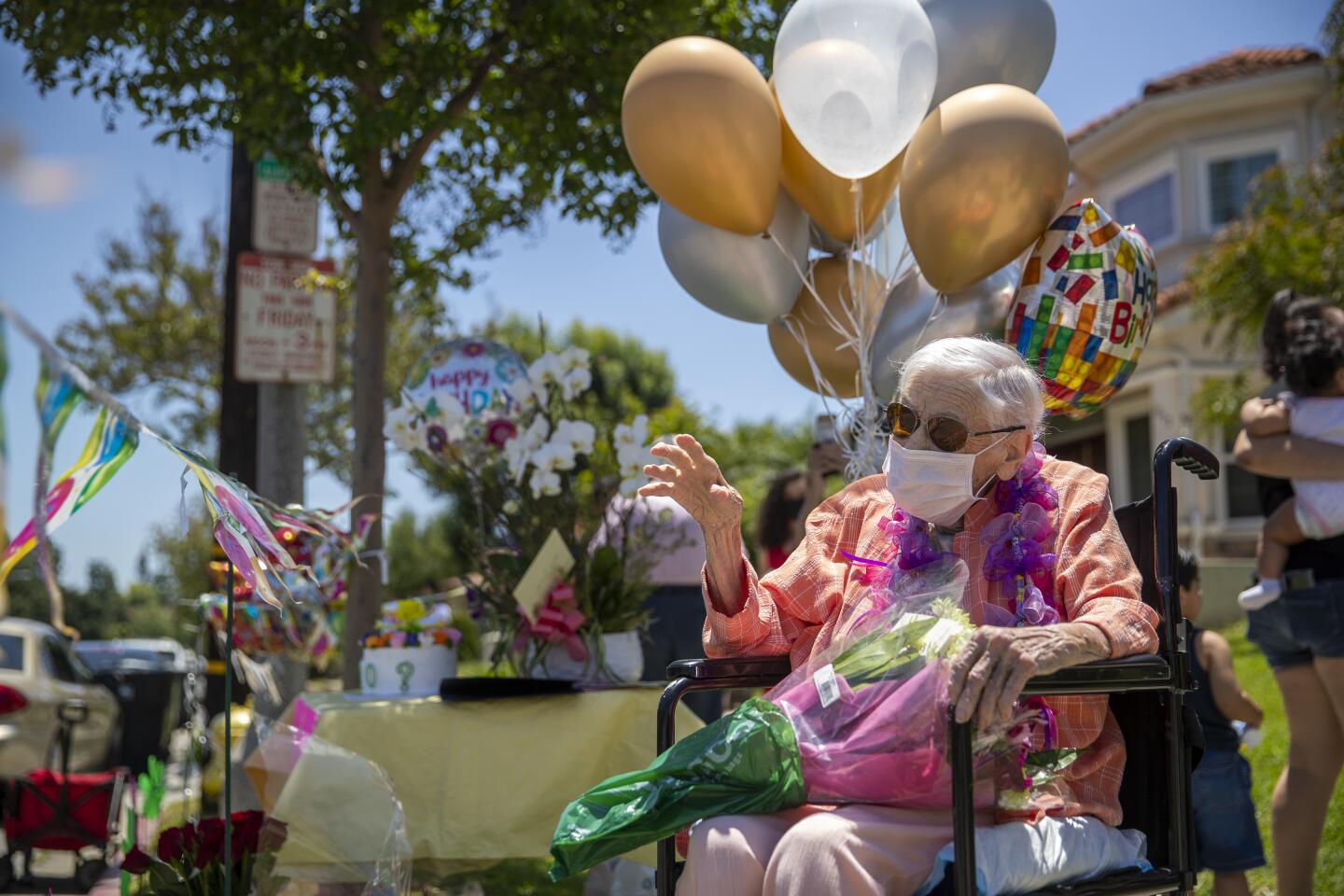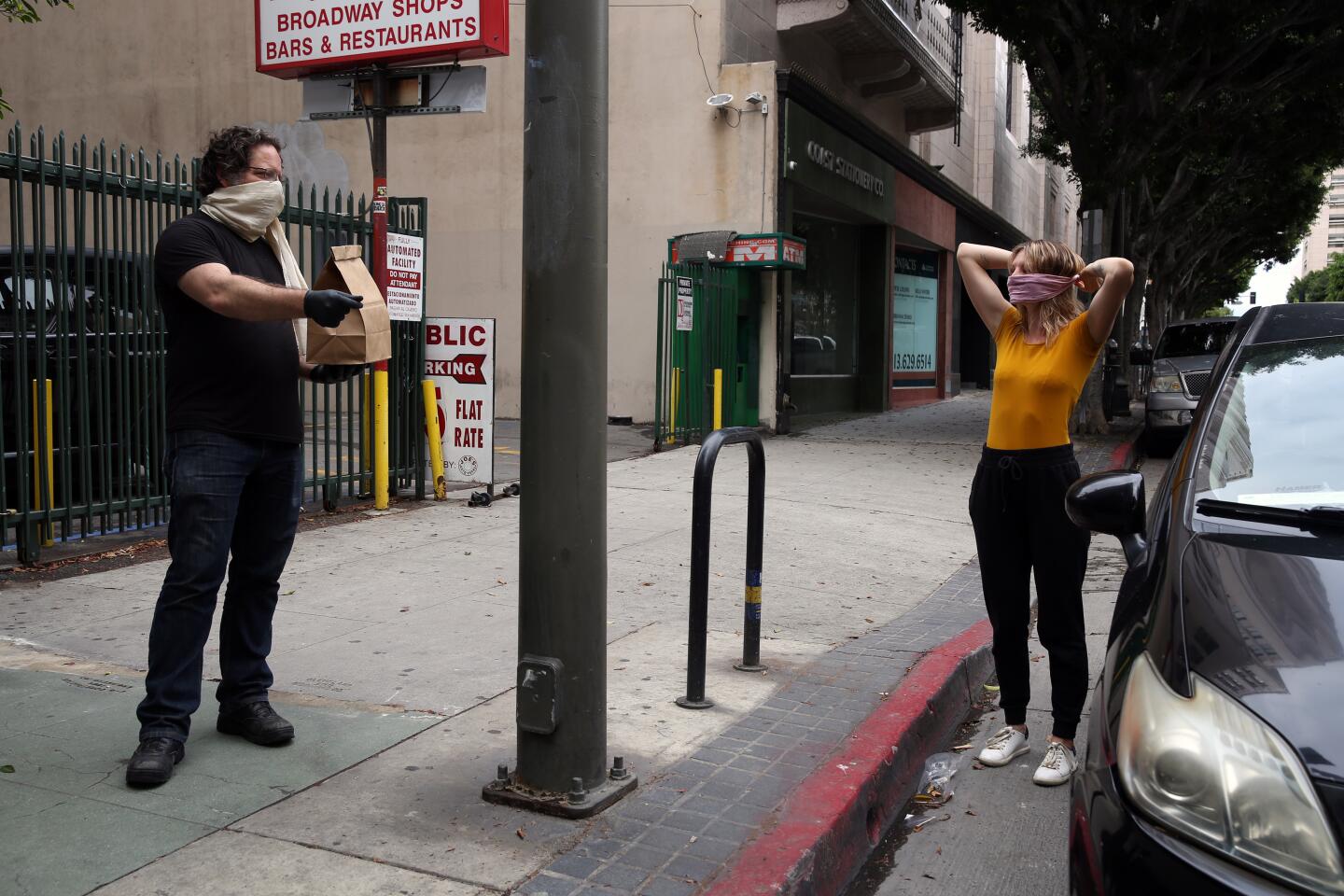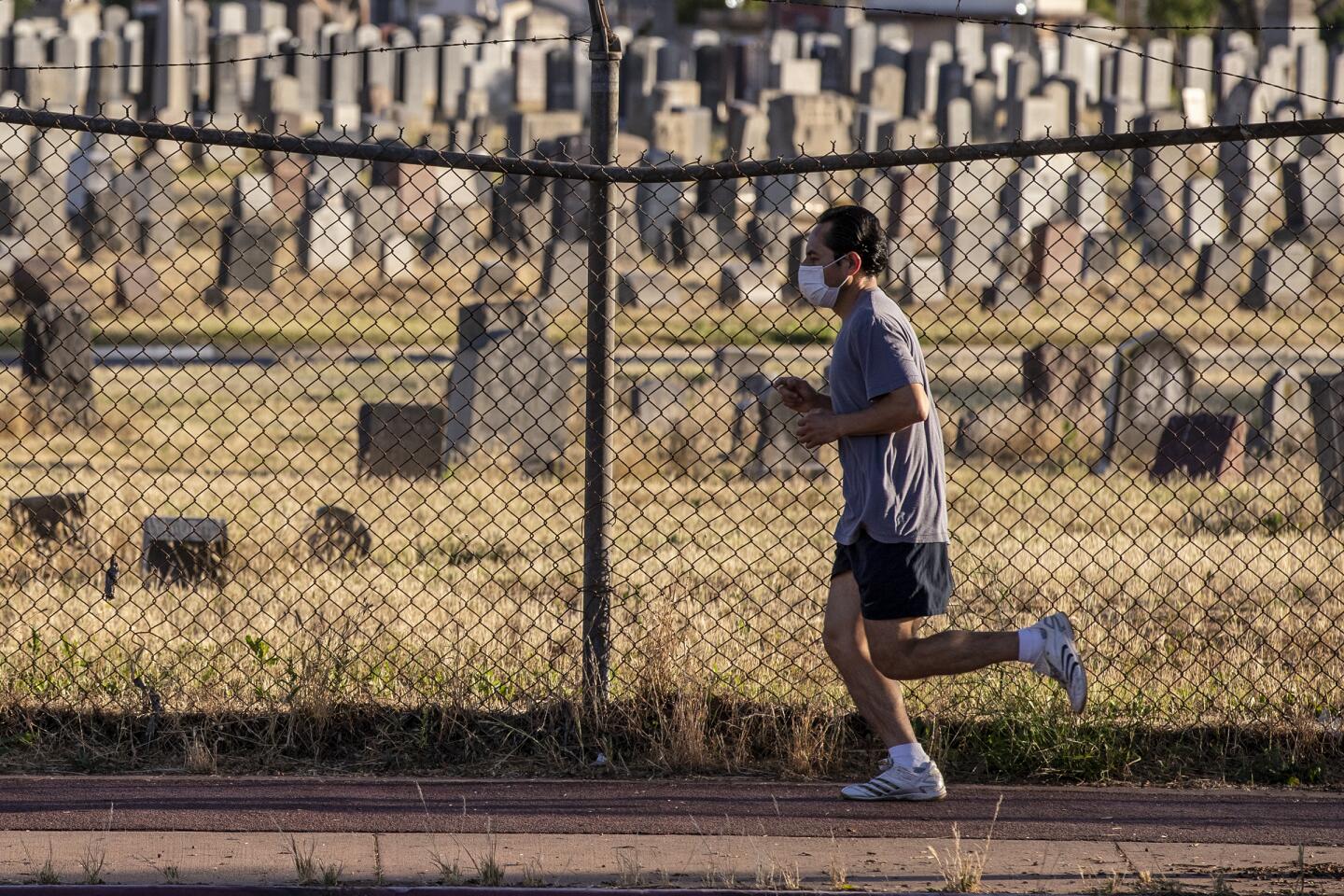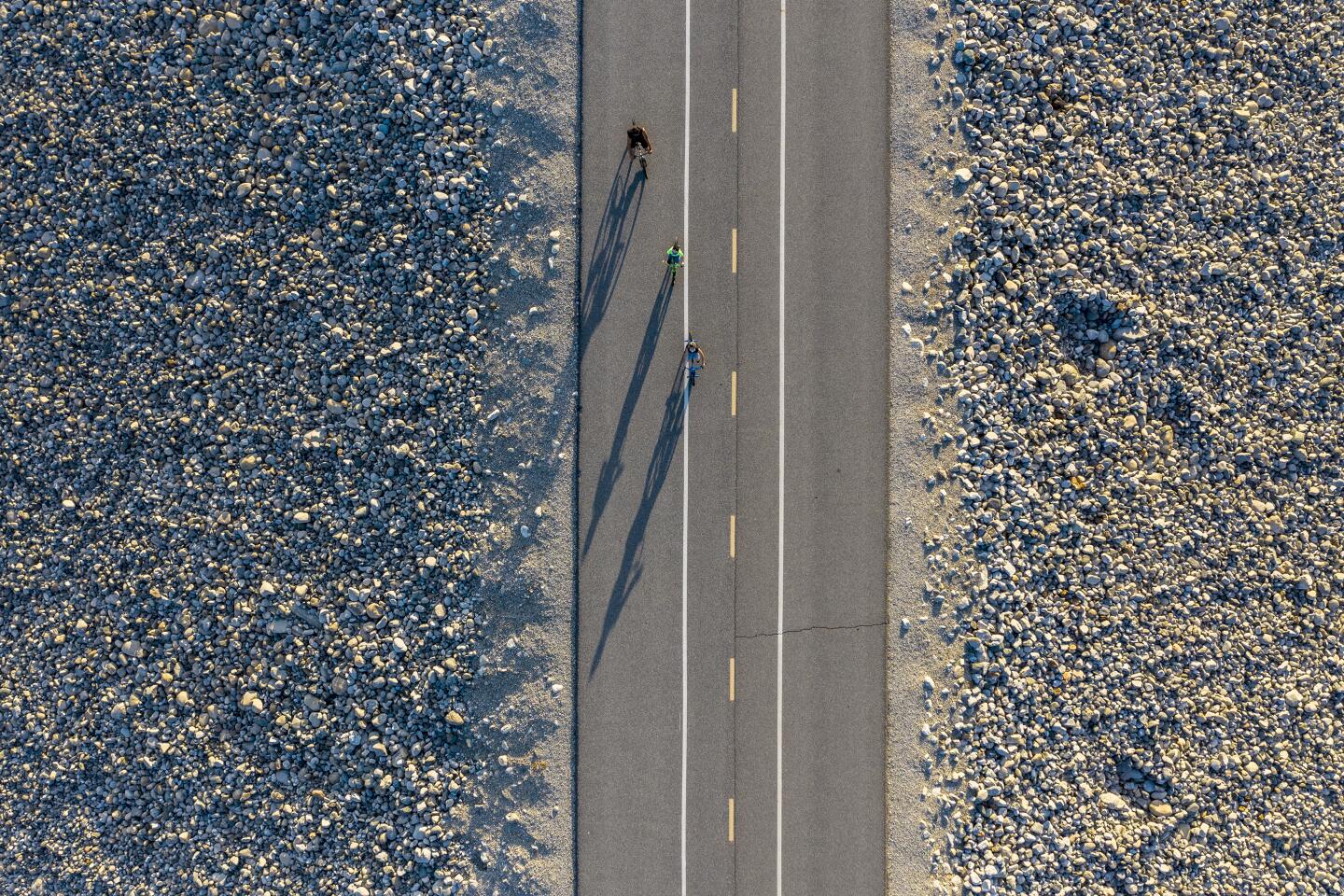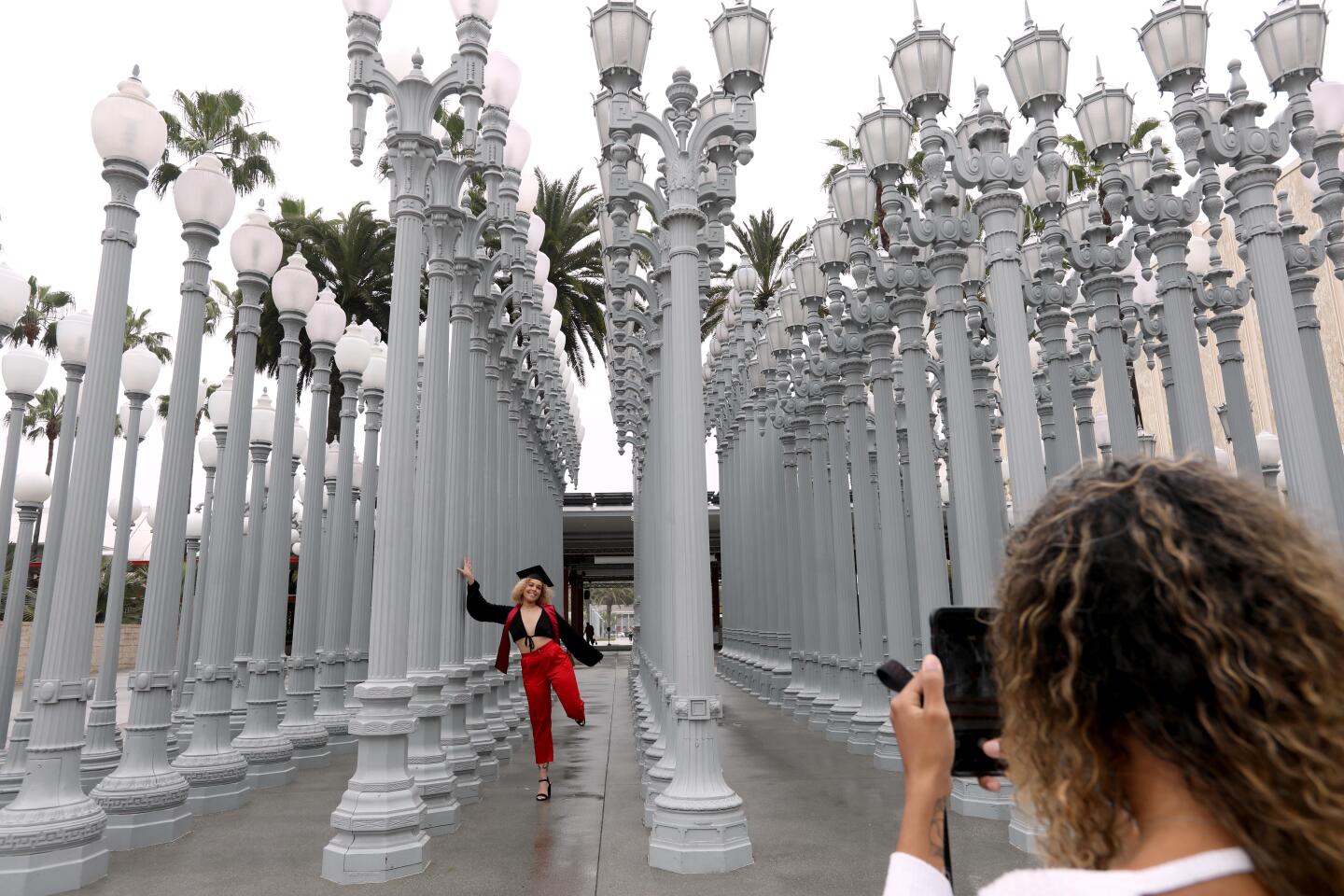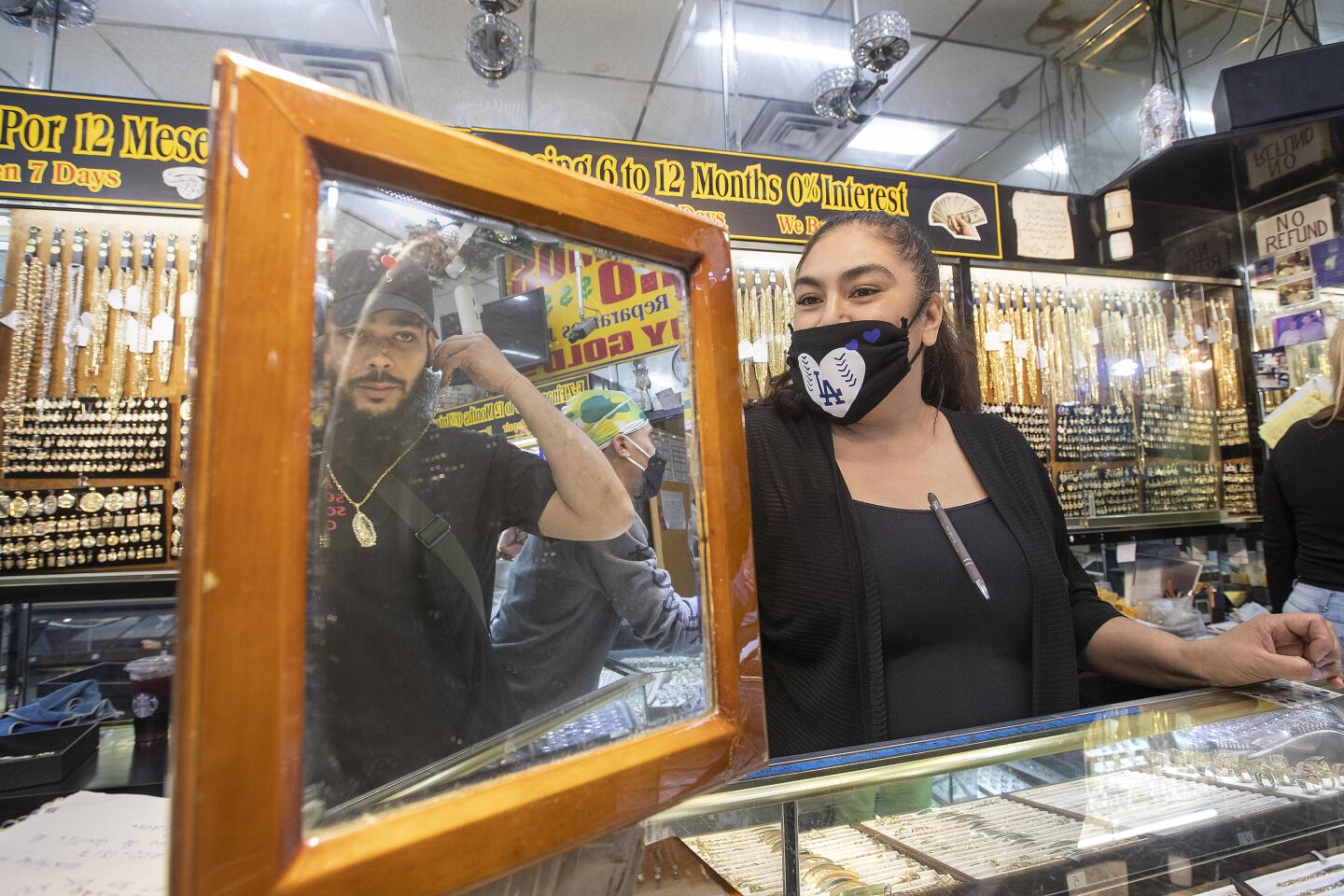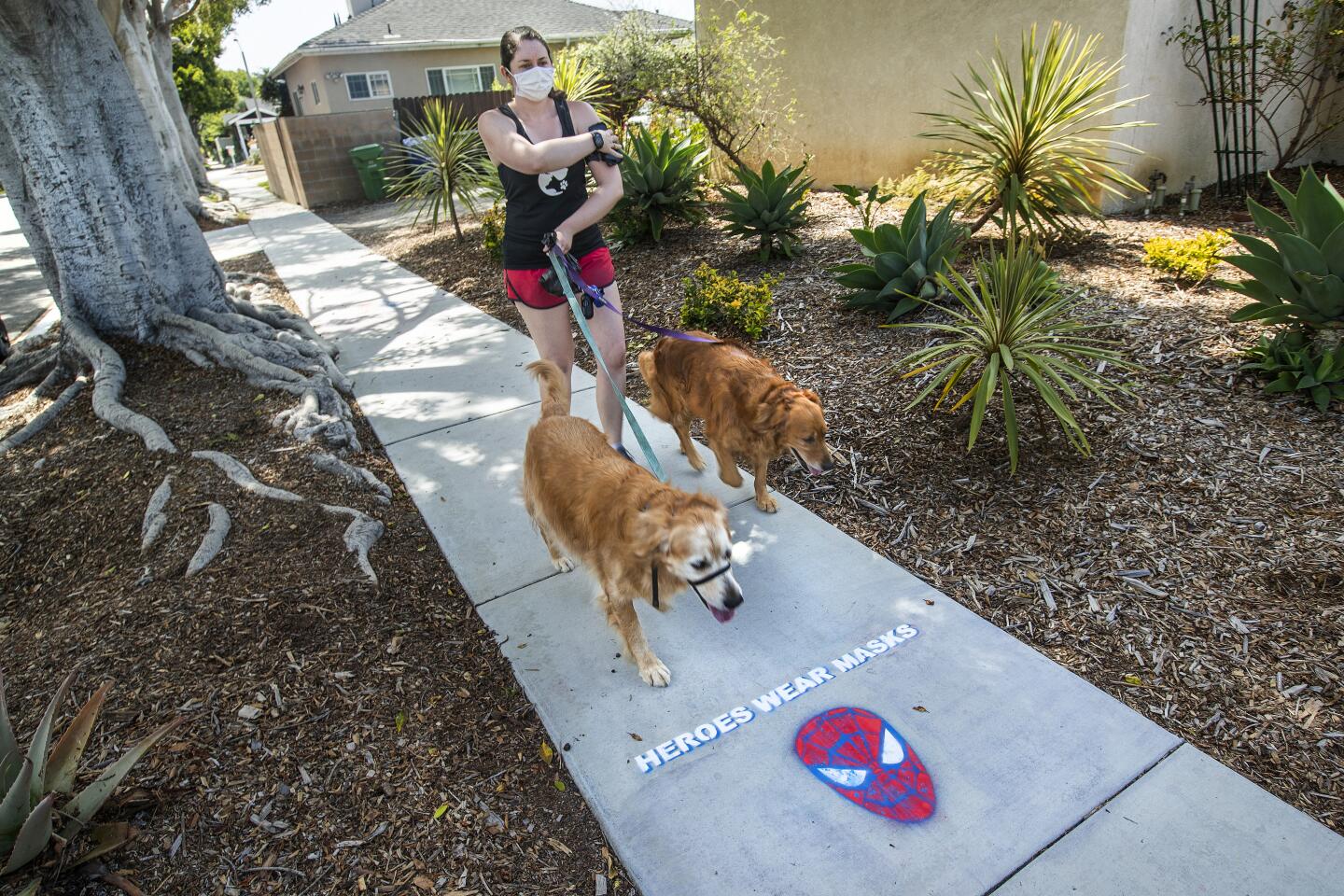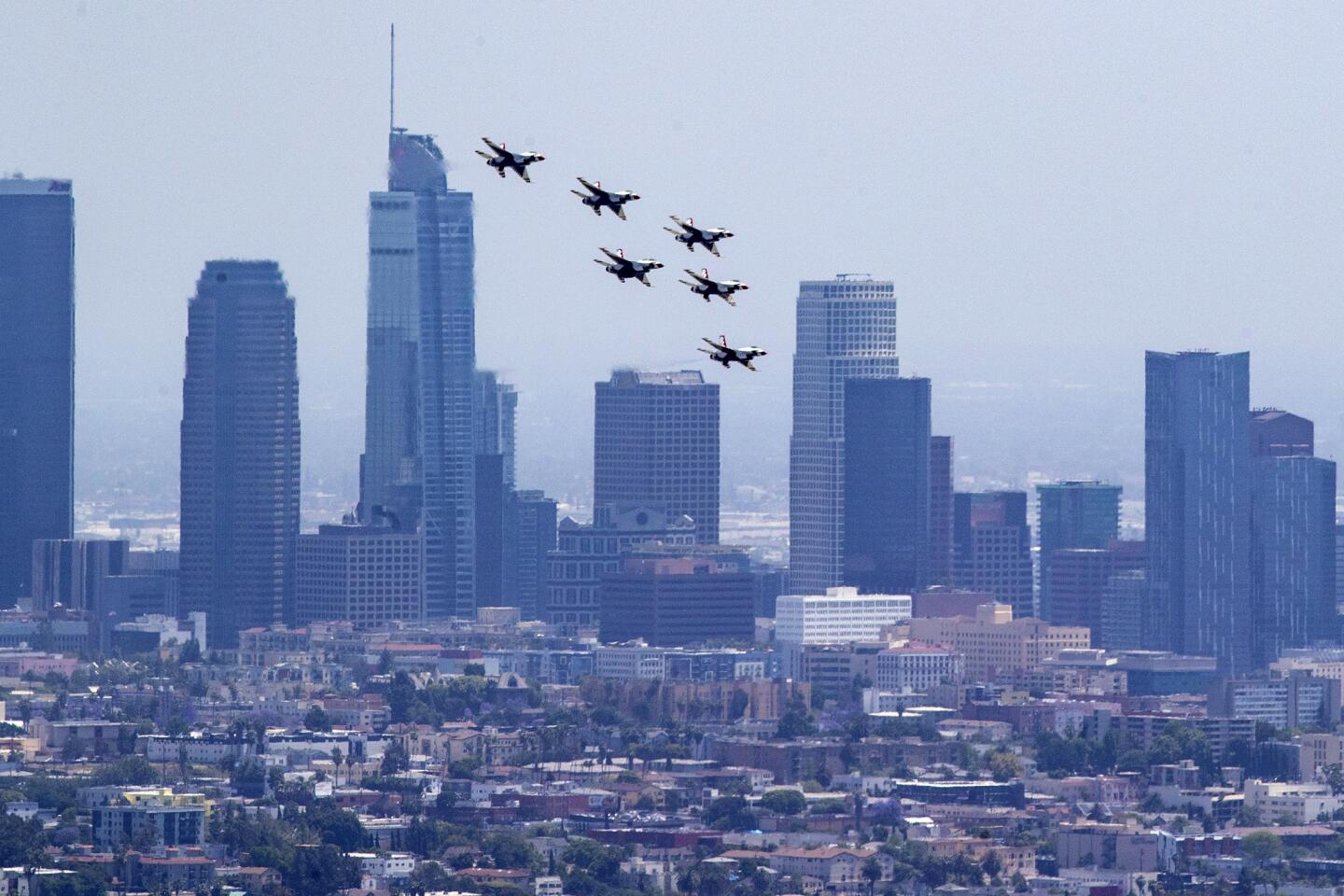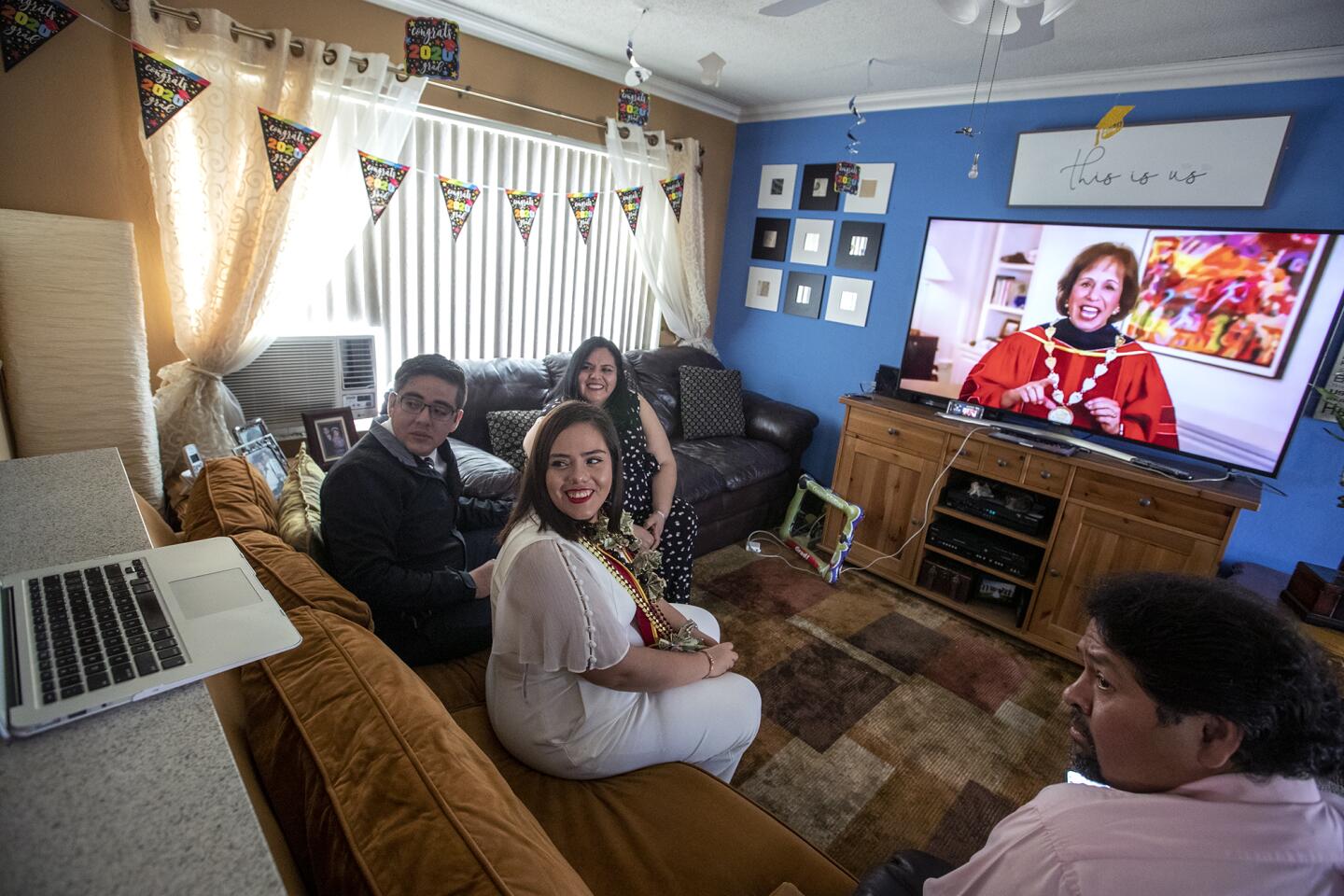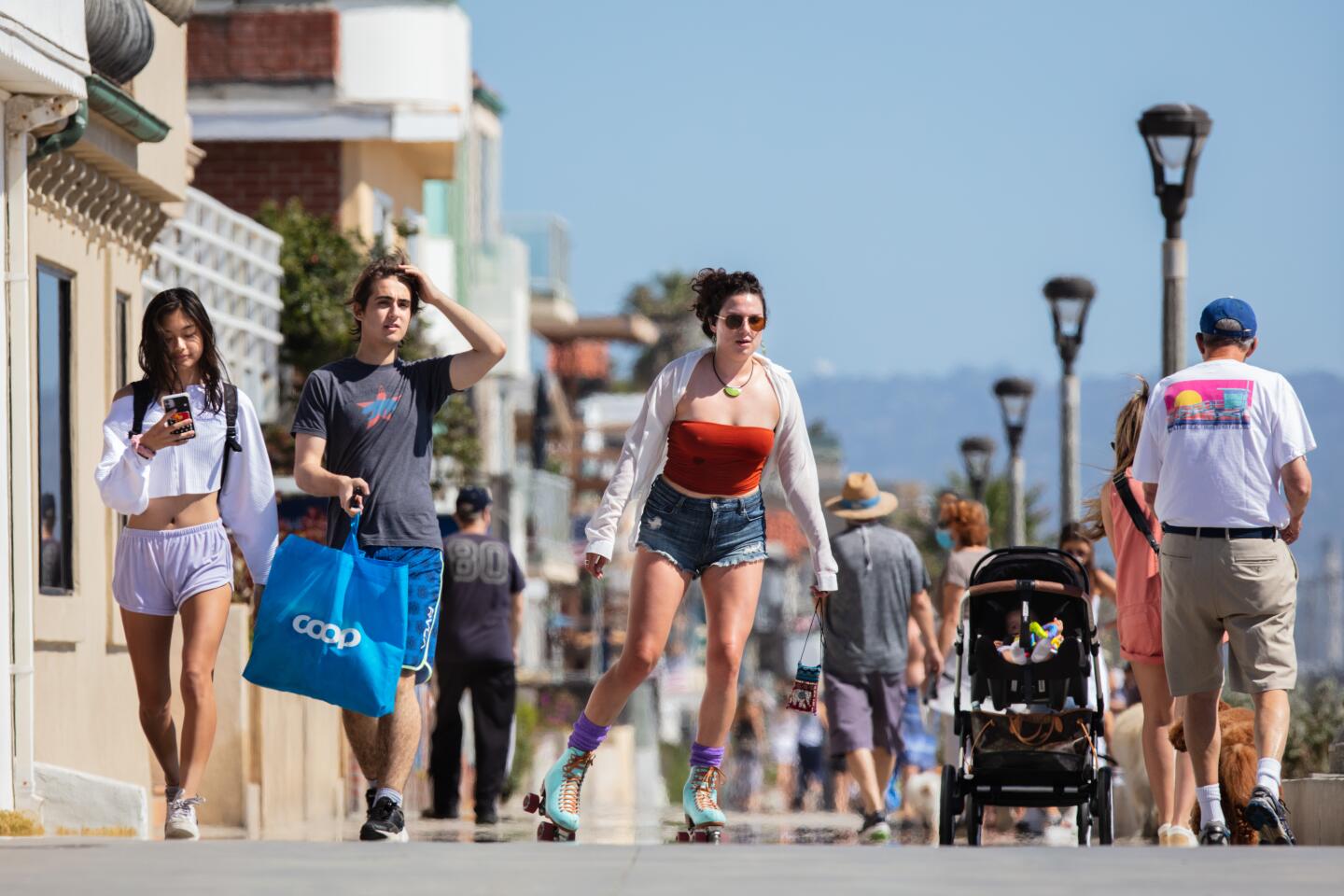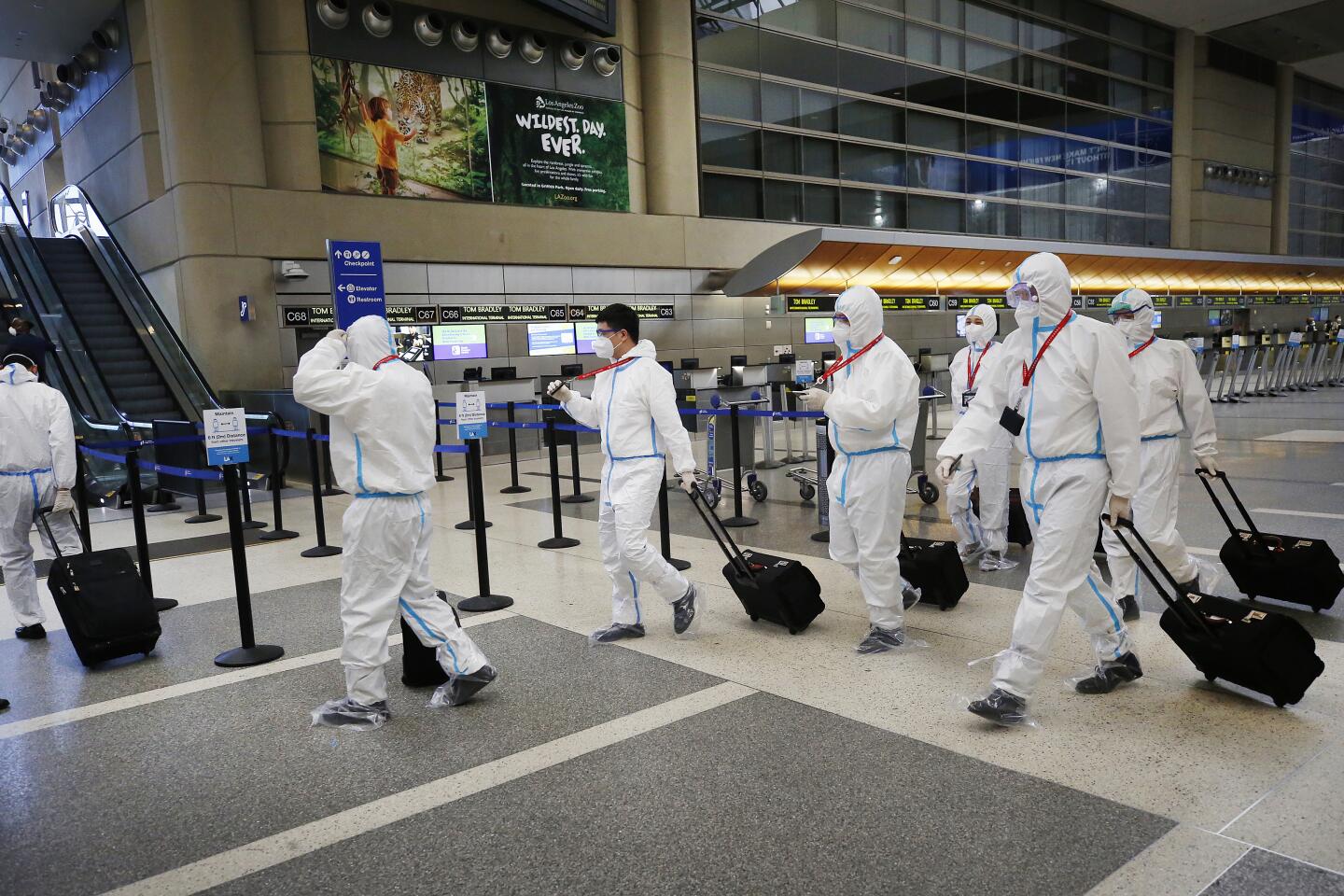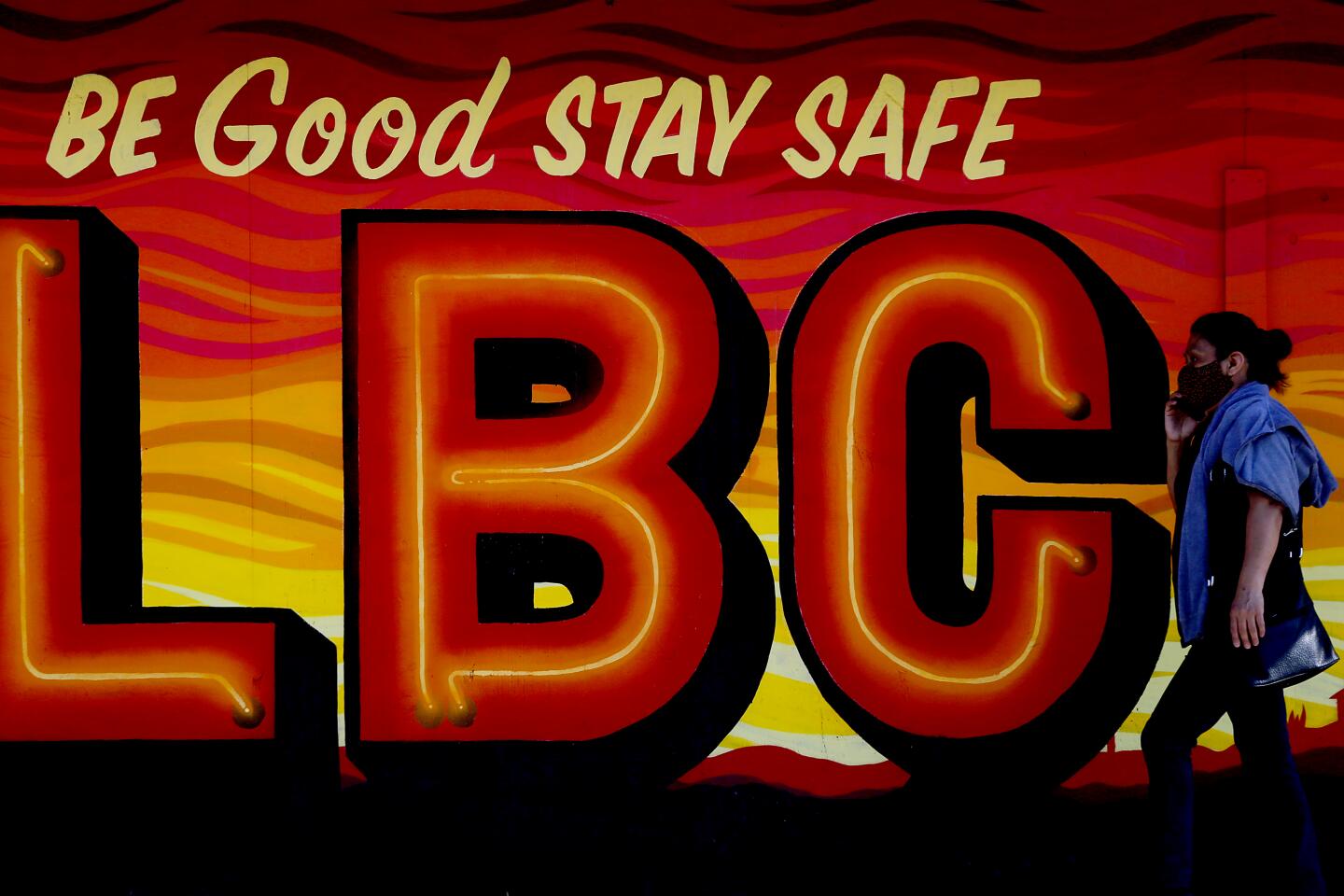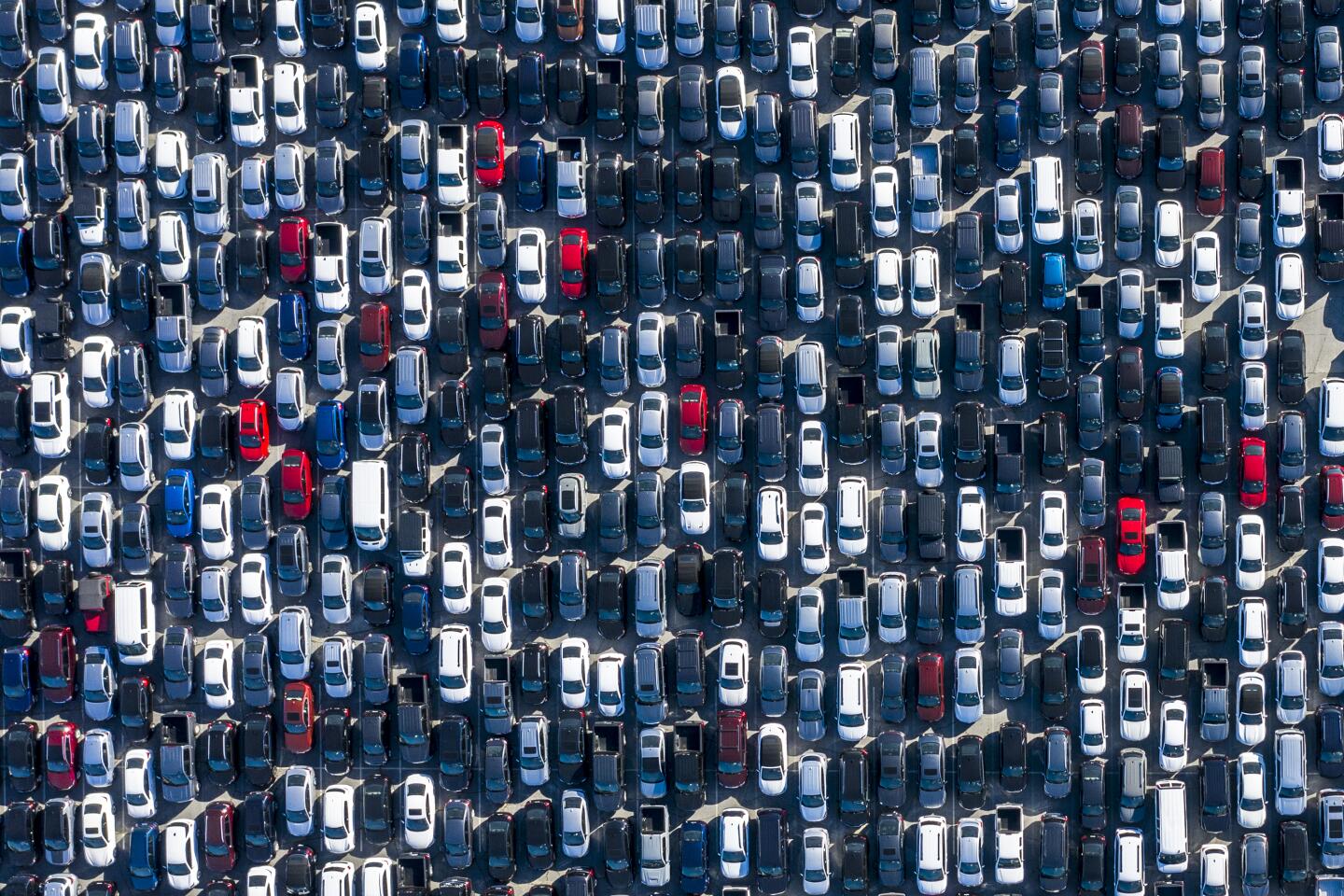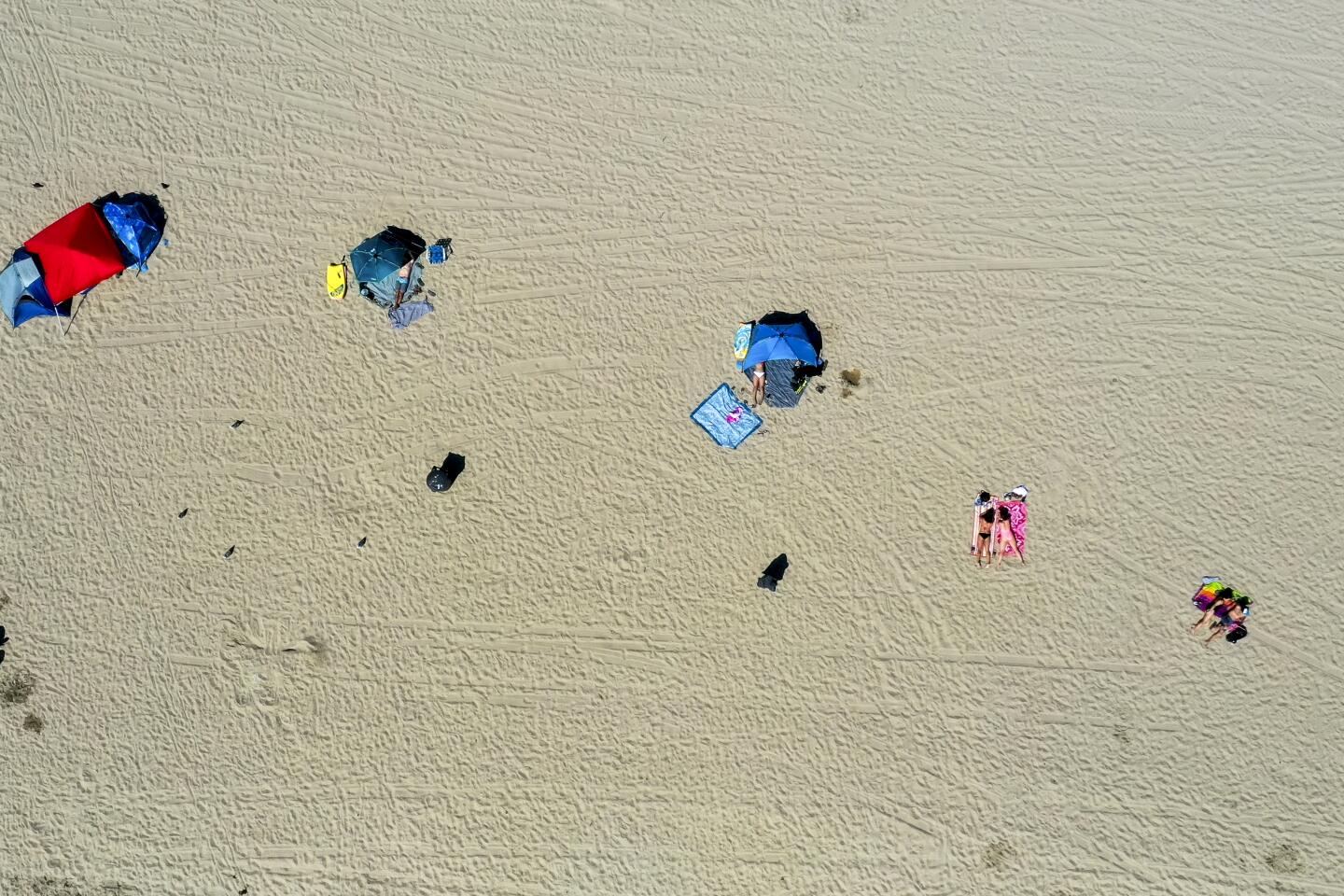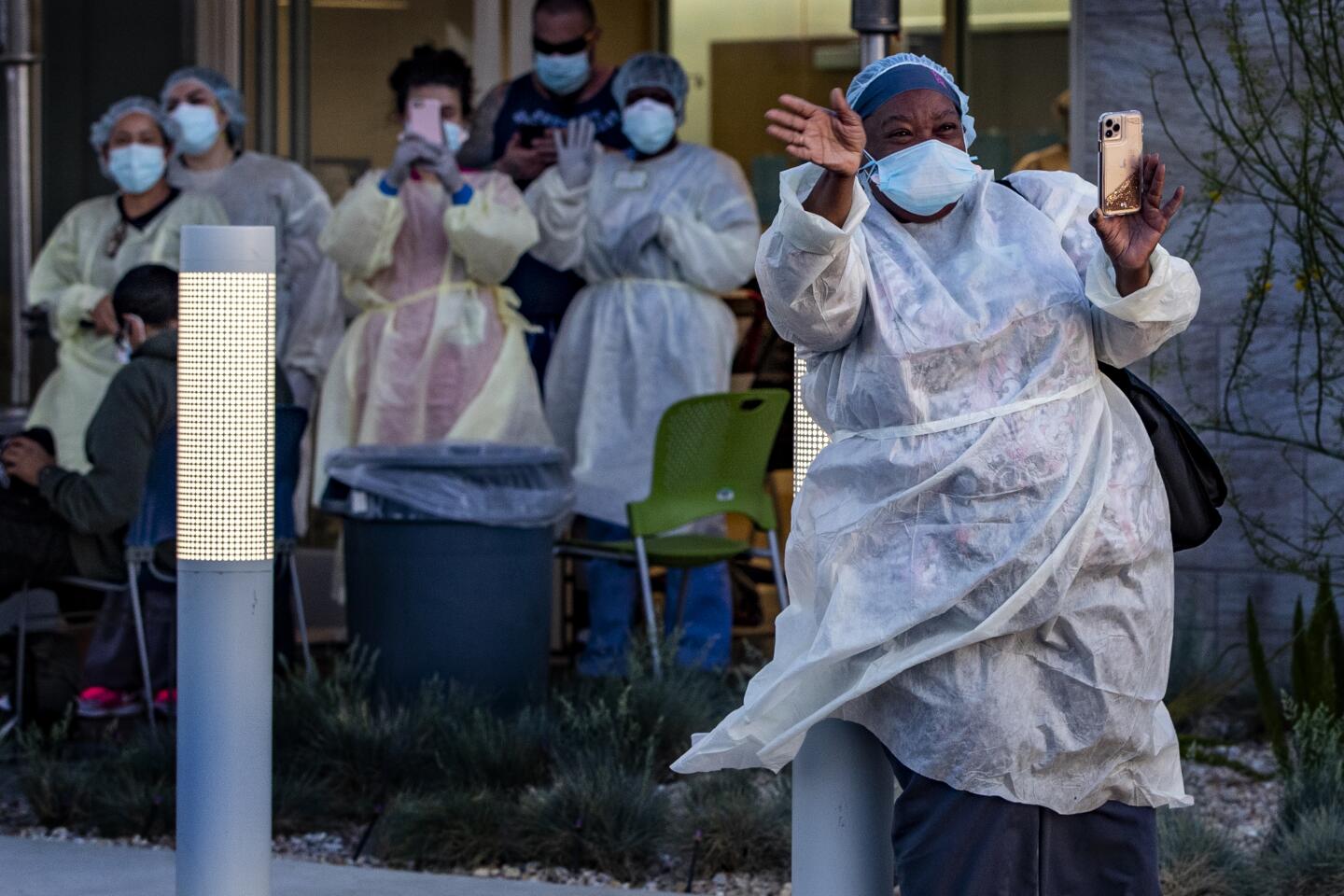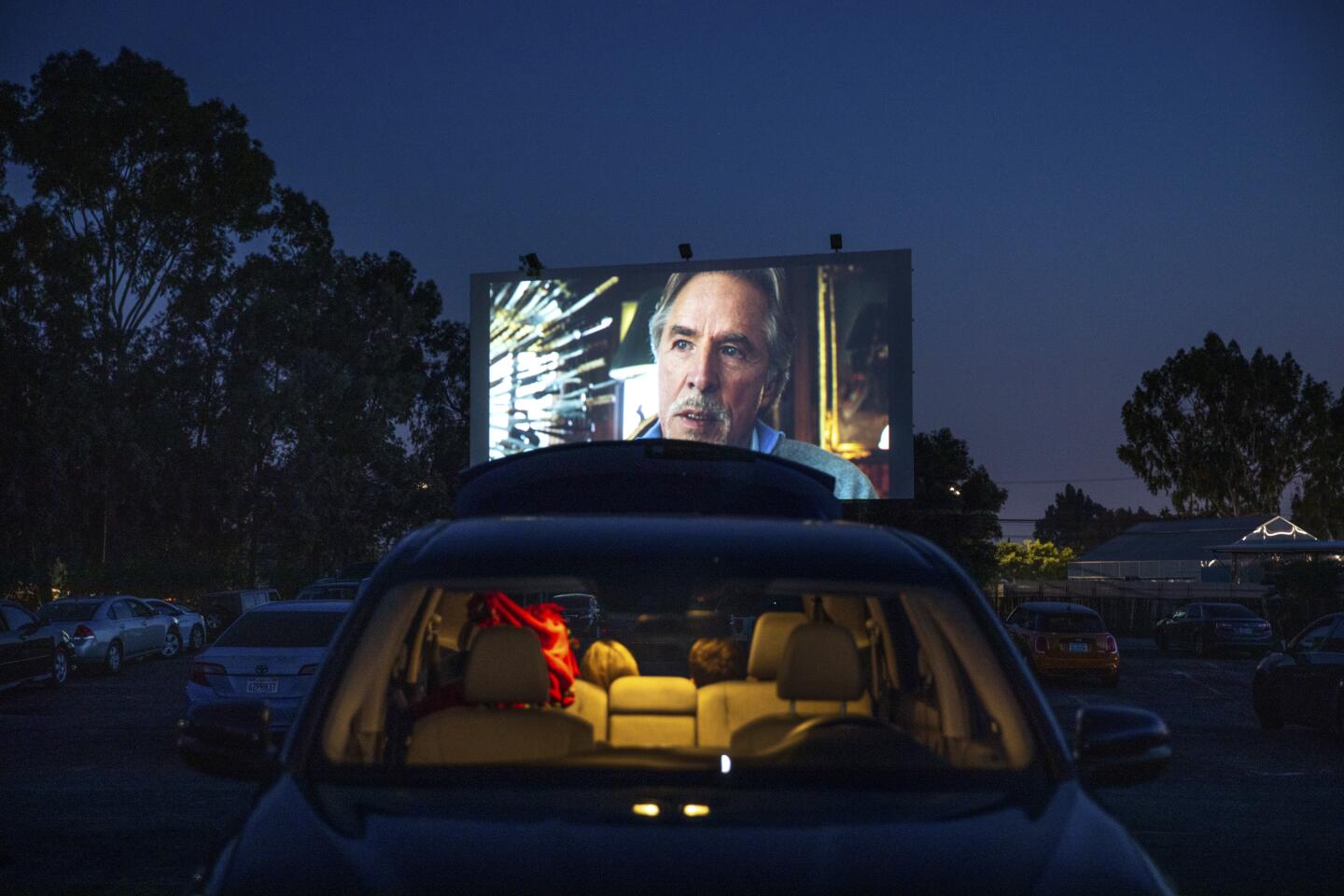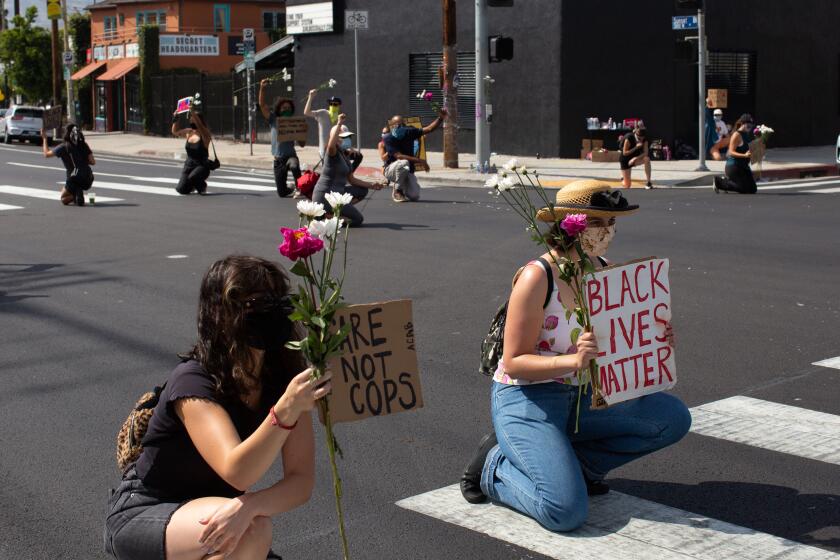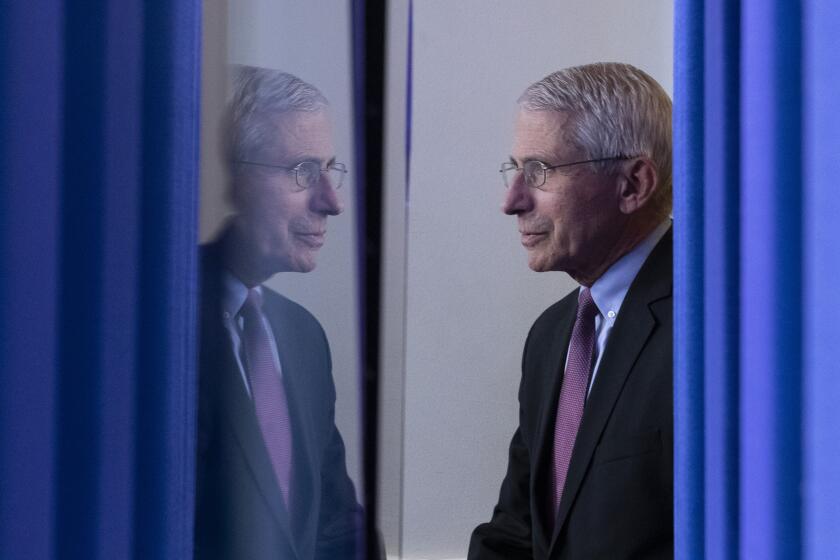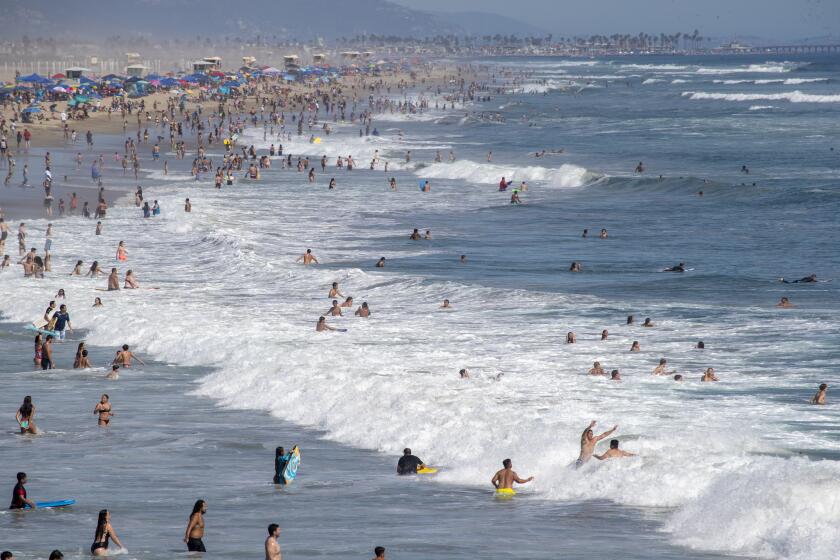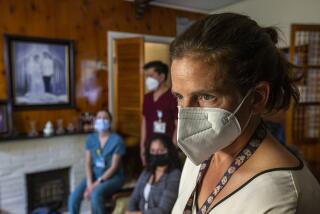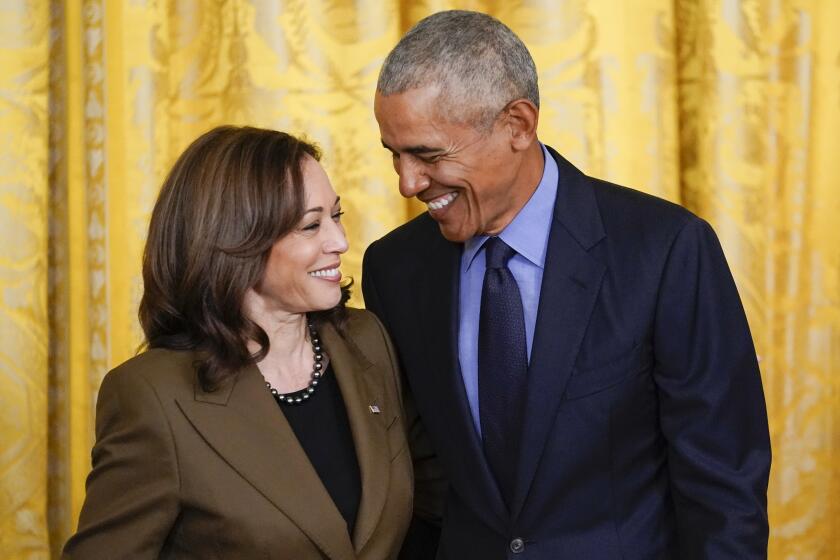L.A. mayor urges residents to stay home as coronavirus cases spike
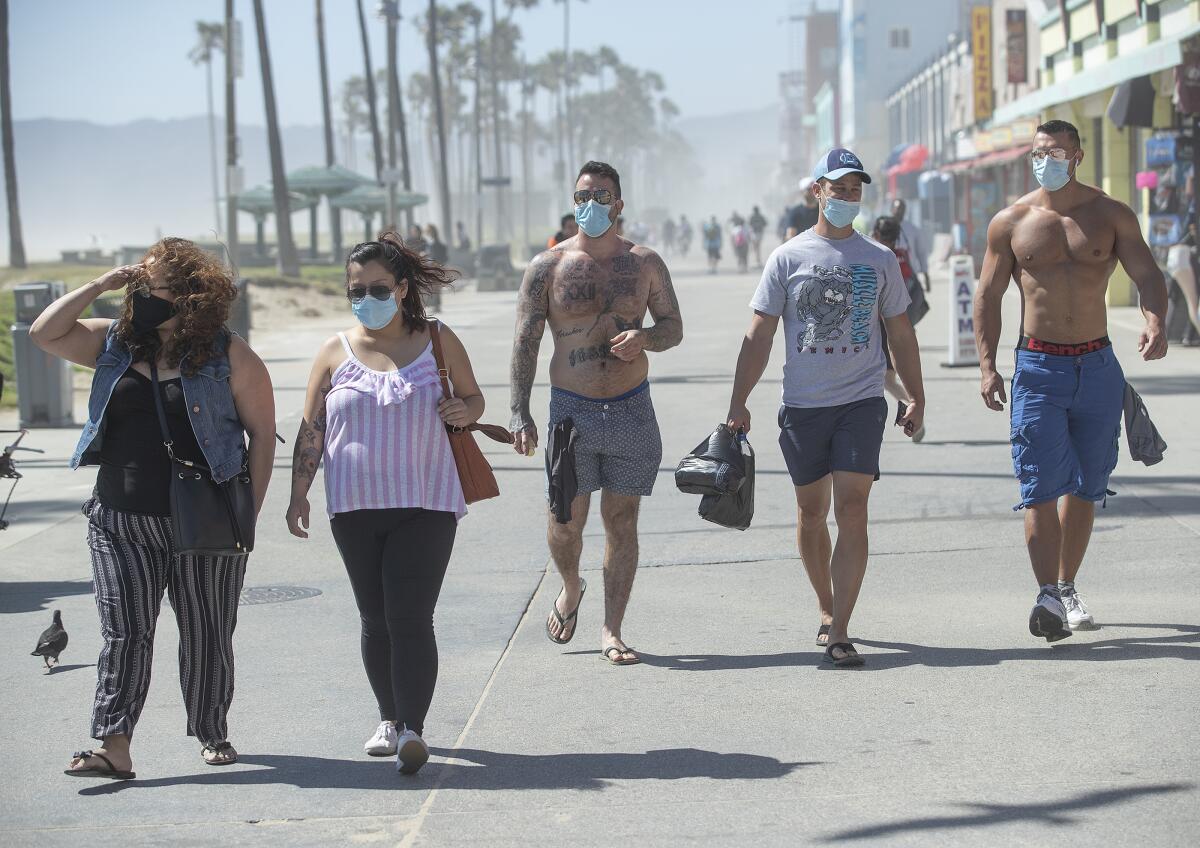
Amid record-setting spikes in newly confirmed coronavirus infections, L.A. Mayor Eric Garcetti urged Angelenos to continue staying home as much as possible — even as the region’s economy gradually emerges from its pandemic-induced coma.
During a briefing Wednesday, Garcetti shared four major takeaways: “One, COVID-19 is still here. Two, COVID-19 is still dangerous. Three, we’re adding more testing to make sure that we can find COVID-19 where it lives. And, four, we must continue to take precautions to keep our city and our people safe.
“That’s why wearing a face covering, that’s why practicing physical distancing, washing our hands and, yes, still, as painful as it might feel, staying at home whenever we can is our best defense,” he said.
Starting Thursday, Garcetti said, Los Angeles would dramatically ramp up capacity at its COVID-19 test sites, from 7,700 to 13,700 tests per day, to meet increased demand.
The announcement comes on the heels of news that many have been unable to book testing appointments, particularly following massive protests against police brutality that prompted health officials to urge demonstrators to get screened.
There have been 91,467 confirmed coronavirus infections and 3,246 deaths in L.A. County.
That total caseload has been fueled by significant spikes of late — including several days in which the county reported more than 2,000 new infections.
“I know this is difficult. It’s summer. Restaurants and bars are open, and things seem like they’re back to normal,” L.A. County Public Health Director Barbara Ferrer said Thursday. “But they’re not. The virus is deadly. The virus remains in our community.”
Health officials have repeatedly said that case counts would rise as more businesses and public spaces reopened, and California set back-to-back records this week in terms of daily reported coronavirus cases.
The state shattered a daily record for new cases Monday, reporting more than 6,000 infections for the first time. That number surged even higher Tuesday, when 6,652 new cases were reported.
Los Angeles County residents struggle to schedule coronavirus tests even as officials report a troubling surge in people infected with COVID-19.
The state reported 4,629 new cases Wednesday, according to The Times’ coronavirus tracker — pushing its cumulative total past 196,000. More than 5,700 Californians have died from COVID-19, including 98 on Wednesday.
“While you may be done with COVID, COVID is not done with us,” Garcetti said.
Cumulative case counts are only part of the equation. Health officials have said other metrics — such as the number of patients who require hospitalization and the positivity rate — help paint a more complete picture of the coronavirus outbreak.
However, there are warning signs there too.
Gov. Gavin Newsom warned Californians on Thursday about the growing spread of the coronavirus as the state again reported increases in hospitalizations.
The governor’s news conference marks the third time this week that he has urged Californians to take more precautions as he disclosed troubling new highs.
“I cannot impress upon people more the importance at this critical juncture, when we are experiencing an increase in cases that we have not experienced in the past, to take seriously this moment,” Newsom said. “If we do, we can mitigate and we can bend, and we ultimately can rebound and become more resilient still in the future.”
Newsom said Thursday that patients hospitalized from COVID-19 had jumped 32% in the last two weeks — to 4,240. That is double the two-week increase of 16% he reported Monday.
The rate of positive cases remains stagnant at 5.1% over two weeks compared with Wednesday, he said.
The governor has pleaded with residents to wear masks and maintain a physical distance of six feet from one another. He advised those over the age of 65 or with chronic medical conditions to remain at home.
The news came shortly before Dr. Anthony Fauci warned that easing restrictions does not mean it’s safe to resume normal life again.
But beyond telling Californians to heed the state’s mask requirement, the governor has not reinstated any of the restrictions he began easing in early May or demanded that counties experiencing surges shutter businesses again.
Fifteen counties in California, including Los Angeles, have reported an elevated transmission of the disease, increased hospitalizations or a limited hospital capacity that exceed the state’s guidelines: Contra Costa, Fresno, Imperial, Kern, Kings, Los Angeles, Riverside, Sacramento, San Bernardino, San Joaquin, Santa Barbara, Santa Clara, Stanislaus, Tulare and Ventura.
Newsom said Thursday that he would consider “toggling back” and reinstituting restrictions if healthcare needs began to exceed capacity.
“When our system cannot absorb, when there’s a capacity consideration or limitation, that’s when we obviously have alarm bells that are raised,” he said.
While L.A. County saw an average of 62 fewer hospitalized patients daily for confirmed or suspected cases of COVID-19 between the week of Memorial Day and last week, Riverside County saw an average daily increase of 85 patients; San Bernardino County, 70; Ventura County, 33; and Orange County, 32, according to a Times analysis.
But L.A. County has seen its daily number of hospitalizations tick up recently — something Ferrer called “extraordinarily worrisome.”
Orange County also reported 26 COVID-19 deaths Wednesday — its most in a single day. Officials noted that not all of those people died on that particular day. The recently reported fatalities date from as far back as May 9, according to the Orange County Health Care Agency.
A review of death certificates resulted in the confirmation of 26 new deaths, the agency reported in a Twitter post offering “our sincere sympathies for the lives lost to this virus, no matter the day.”
The increases in Ventura, Orange, San Bernardino and Riverside counties have contributed to an overall rise in hospitalizations recorded statewide.
Despite the increase in confirmed infections, elected and health officials have not indicated an imminent need to reimpose the kind of restrictions that shuttered and battered California’s economy.
But they continue to emphasize that individual actions shape wider conditions. If residents or businesses don’t follow public health guidance, they potentially create a more fertile environment for the coronavirus to spread.
“Each one of us takes responsibility for doing what we know we need to do to protect each other,” Ferrer said.
Over the weekends of May 30, June 6 and June 13, Ferrer said, county inspectors visited 3,751 restaurants and found that 83% of them were not in full compliance with coronavirus safety rules.
“Most of our work to date has really been providing assistance to restaurants as they reopen so they can come into compliance,” she said.
California reported more than 6,000 infections Tuesday — the largest single-day count in the state since the pandemic hit the U.S.
Newsom warned Wednesday that counties that fail to abide by the state’s COVID-19 guidelines, including the recent face-covering mandate, could lose state funding targeting the coronavirus outbreak.
The governor last week ordered all Californians to wear face coverings while in public or high-risk settings — a move he said was aimed at slowing the spread of the coronavirus and helping keep the state’s reopening plans on track.
However, the requirement has been met with resistance and derision in some corners of the state. Some residents and elected officials have pledged not to follow the order, and some law enforcement agencies have said they will not enforce it.
“There are some that have made rhetorical comments about not giving a damn, flouting any consideration of supporting the broader health directives coming out of the state of California,” Newsom said. “That’s exactly why I look forward to signing this budget that will afford me a little bit of leverage in that conversation and I think that’s the appropriate next step.”
Because the coronavirus respects no boundaries or borders, Garcetti said he hopes leaders across Southern California “will act together so that, if things do get bad and we do need to retreat at all, we’ll do that in unison.”
“I do think that we can get through this without seeing a huge surge, but ... that relies on each one of us,” he said. “It relies on us not being macho about wearing a mask. It relies on each one of us doing the things that we know to do and being patient.”
With the Fourth of July just around the corner, officials continue to emphasize the importance of taking steps to reduce the risk of coronavirus spread — such as physical distancing, frequent hand washing, wearing face coverings and eschewing large gatherings with people from different households.
“We do recognize that families will want to be together over the holiday, but being able to minimize the people that you are around, particularly people that you have not been around in the past, is particularly important,” Dr. Jay Butler, deputy director of infectious diseases and COVID-19 response incident manager for the U.S. Centers for Disease Control and Prevention, said during a briefing Thursday.
Times staff writers Colleen Shalby, Rong-Gong Lin II, Iris Lee, Sean Greene and Phil Willon contributed to this report.
More to Read
Sign up for Essential California
The most important California stories and recommendations in your inbox every morning.
You may occasionally receive promotional content from the Los Angeles Times.
